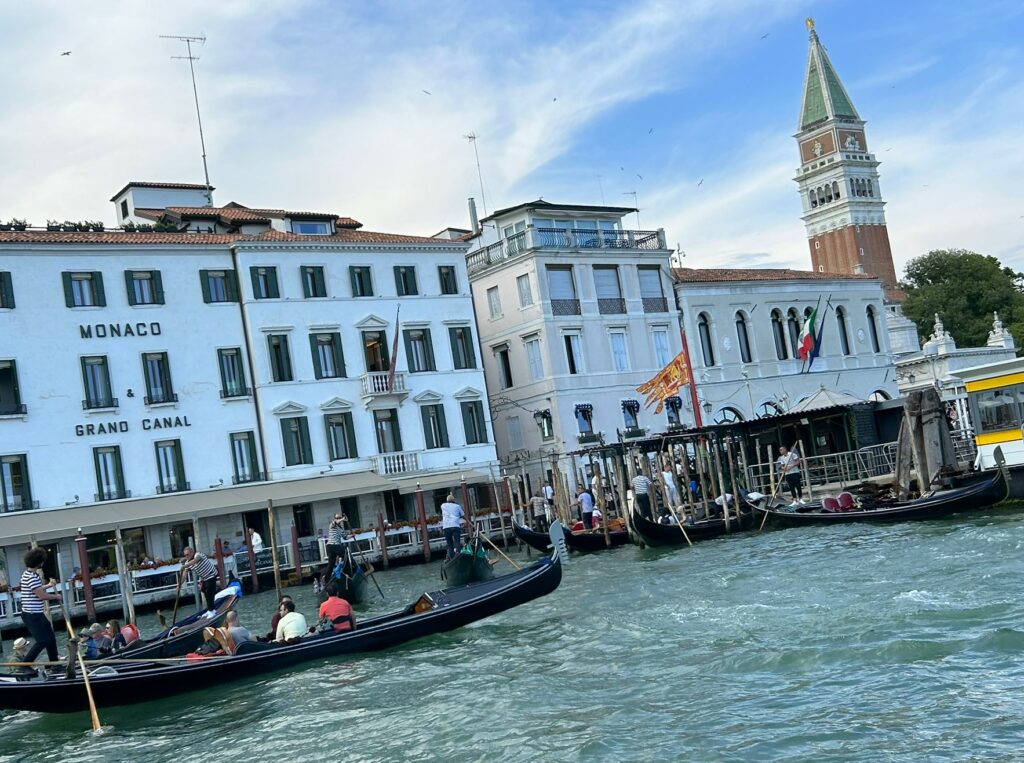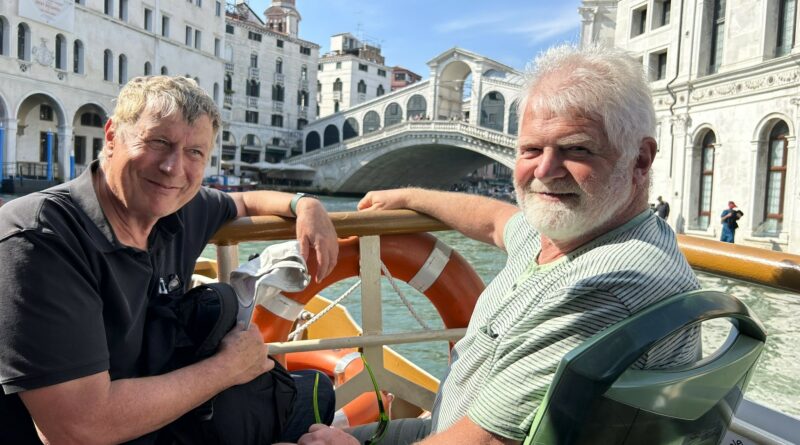„Stranieri Ovunque – Foreigners Everywhere“ bei La Biennale di Venezia mit Frari, Arsenale und Giardini
Ein Tag in Venedig mit Besuchen in der Santa Maria Gloriosa dei Frari und danach bei der 60. Biennale Arte 2024 im Arsenale und in den Giardini #
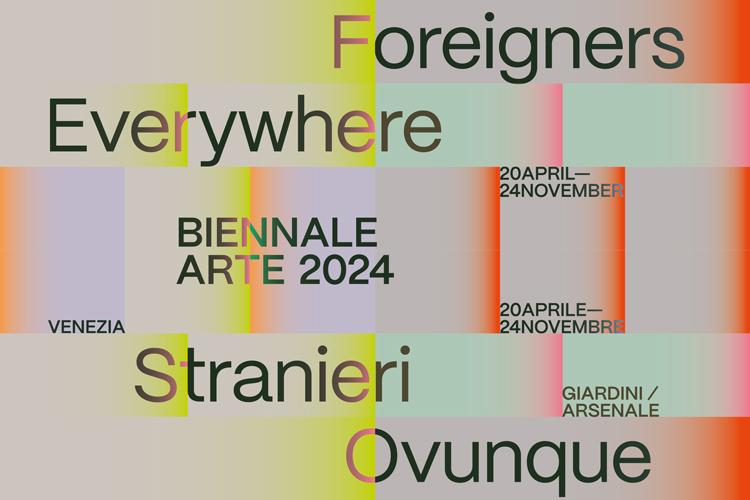
The 60th International Art Exhibition, curated by Adriano Pedrosa, is open from Saturday 20 April to Sunday 24 November at the Giardini and Arsenale venues.

https://www.labiennale.org/en/news/biennale-arte-2024-stranieri-ovunque-foreigners-everywhere
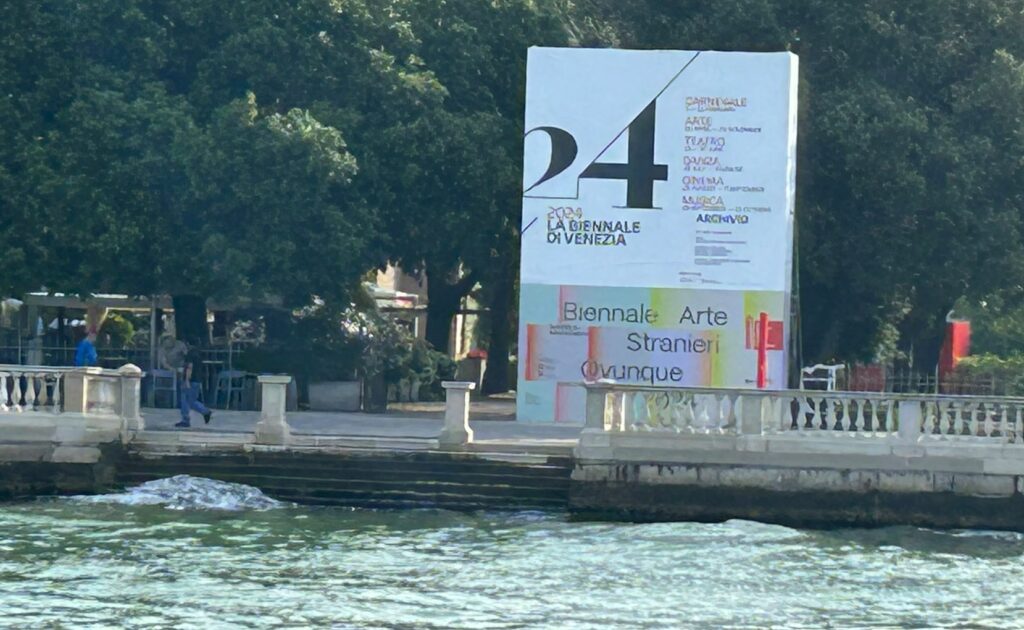
Fahrt von Punta Sabbioni nach Venedig
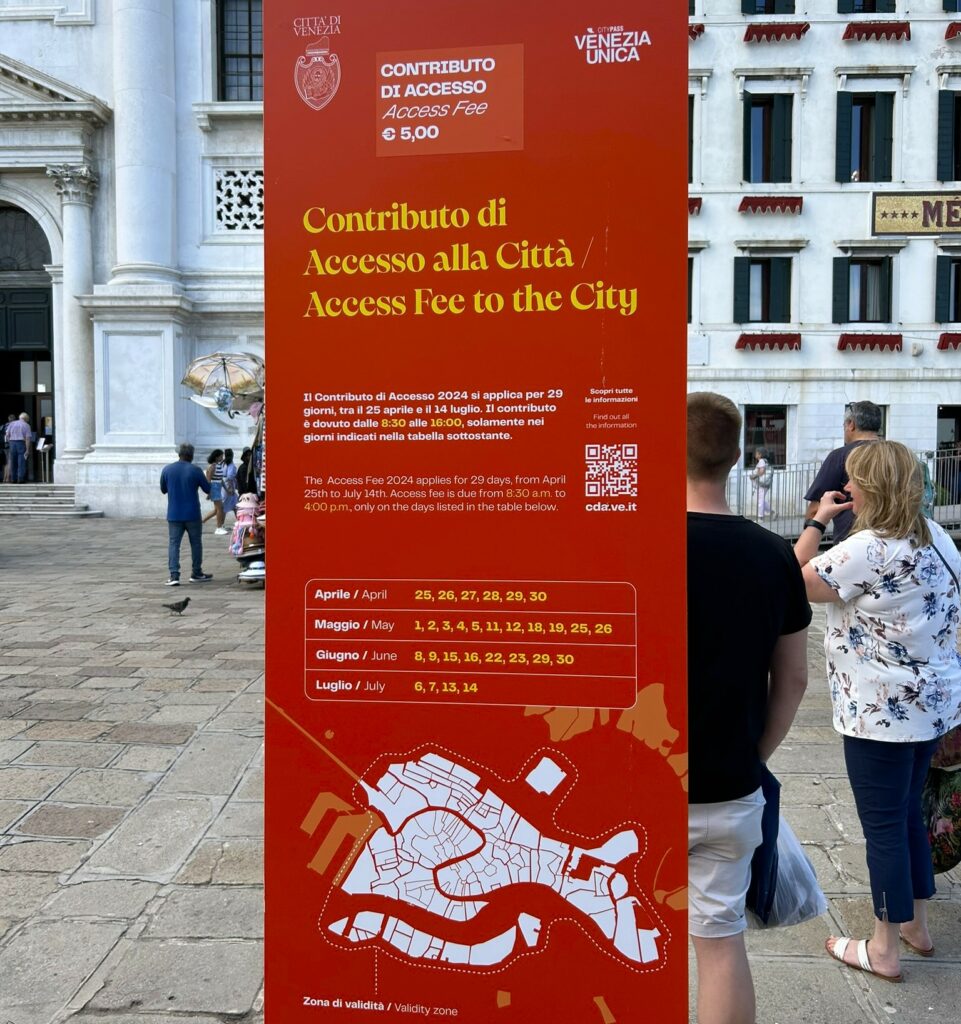
Italien-Reisende, die einen Tagesausflug nach Venedig unternehmen wollen, müssen bis Juli an den Wochenenden Eintritt bezahlen. Dauerhaft wird die Gebühr erst 2025 eingeführt.
-
Venedig-Ticket kostet fünf Euro
-
Betroffen sind die Wochenenden bis Juli
-
Tagesbesucher erhalten bei Bezahlung QR-Code
-
Übernachtungsgäste sind von der Gebühr befreit
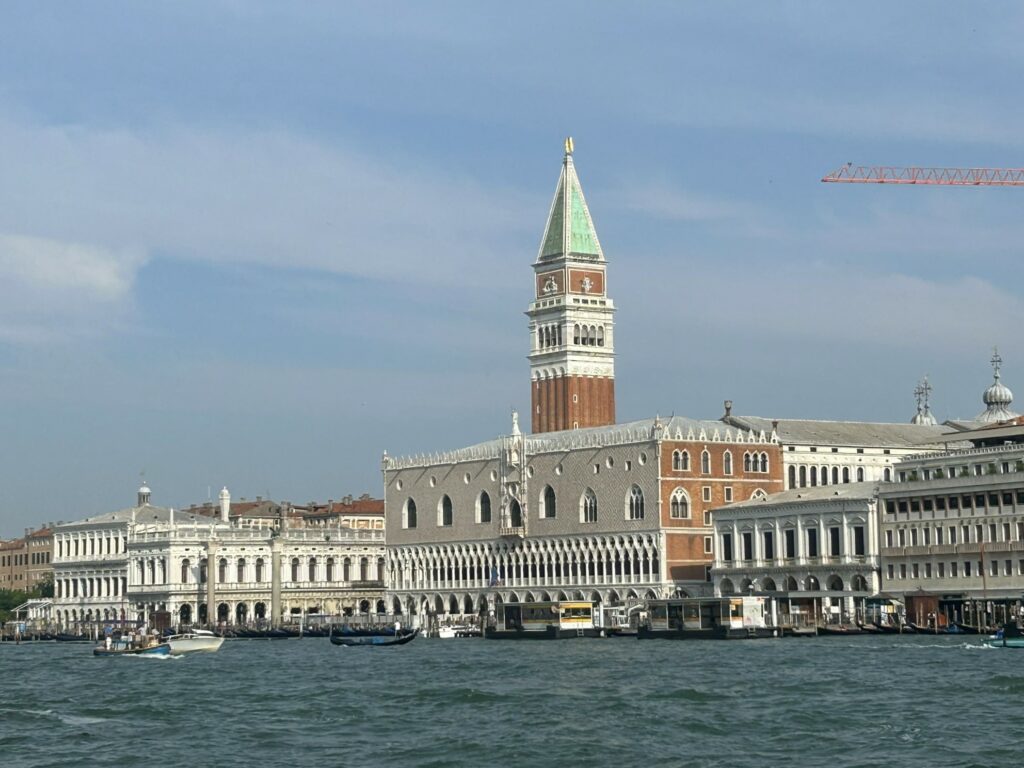
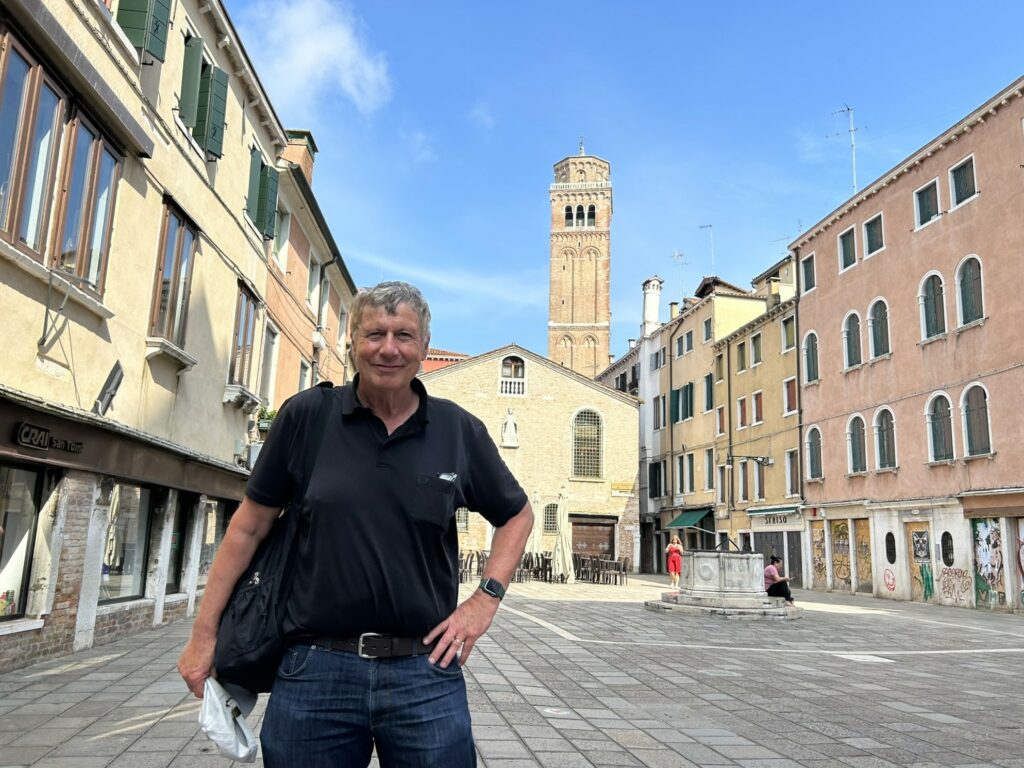
Die Biennale öffnet erst um 11. 00 Uhr, daher gibts zuvor einen Besuch in der Santa Maria Gloriosa dei Frari
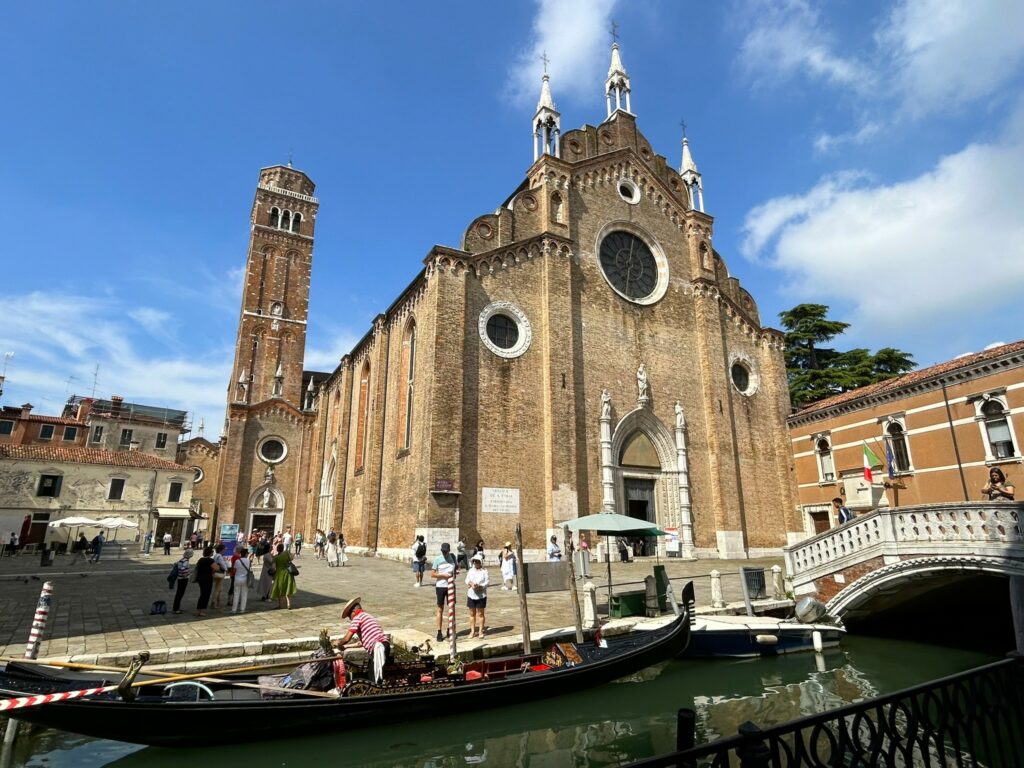
Im Sestiere San Polo am Campo dei Frari befindet sich eine der größten und bedeutendsten gotischen Sakralbauten Venedigs. Es ist die Basilika Santa Maria Gloriosa dei Frari.
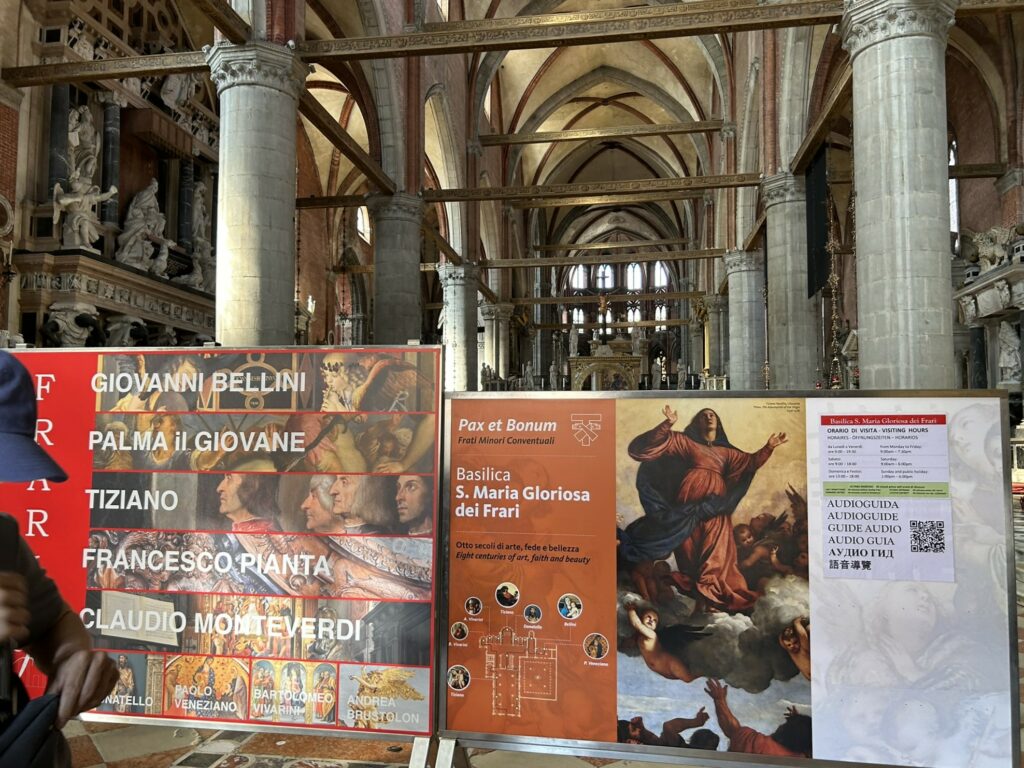
https://de.wikipedia.org/wiki/Santa_Maria_Gloriosa_dei_Frari

Am 19. Mai 1518 wurde das Altarbild Mariä Himmelfahrt von Tizian über dem Hochaltar angebracht.
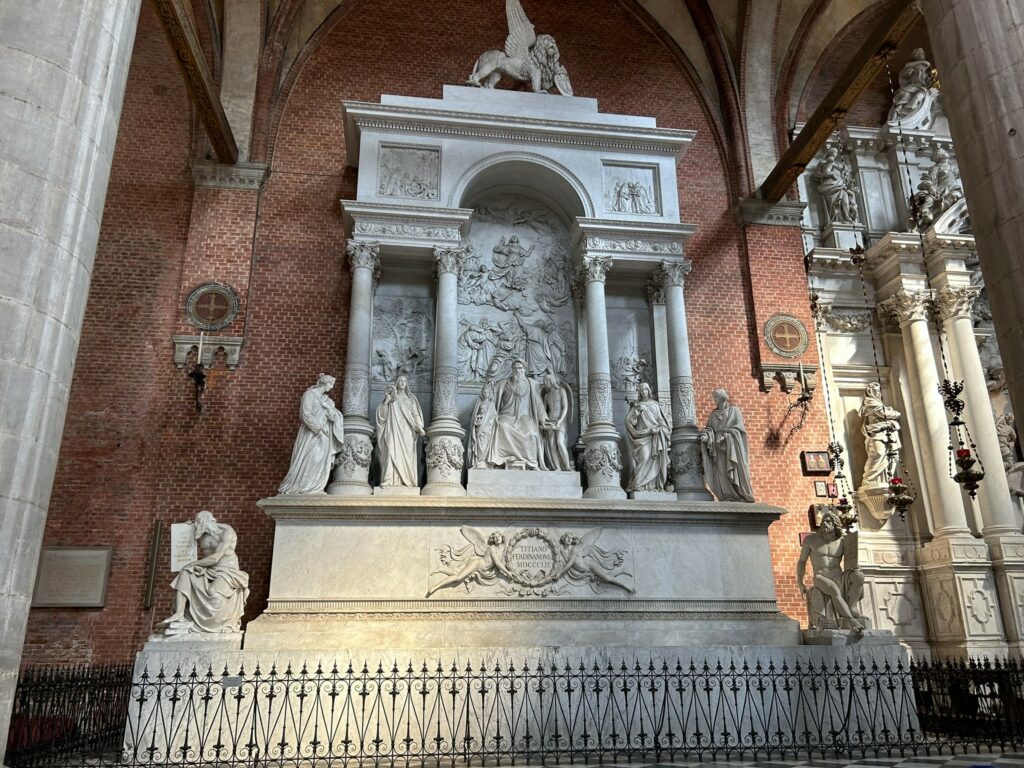
Grabmal für Tizian
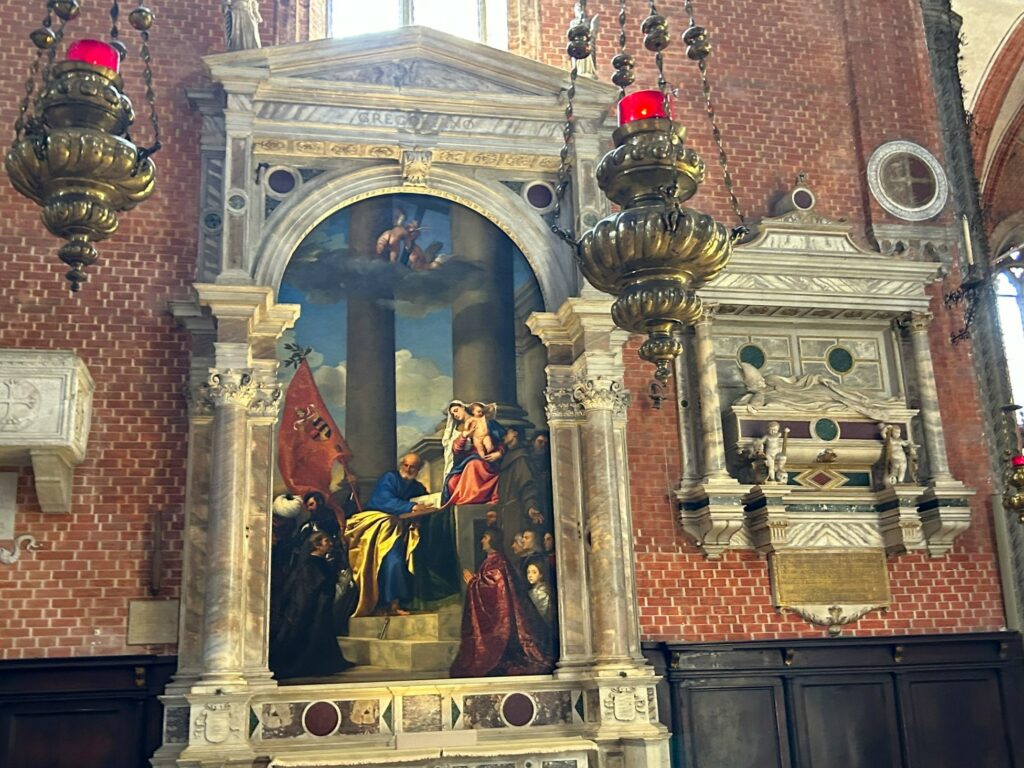
Tizian, Pesaro Madonna
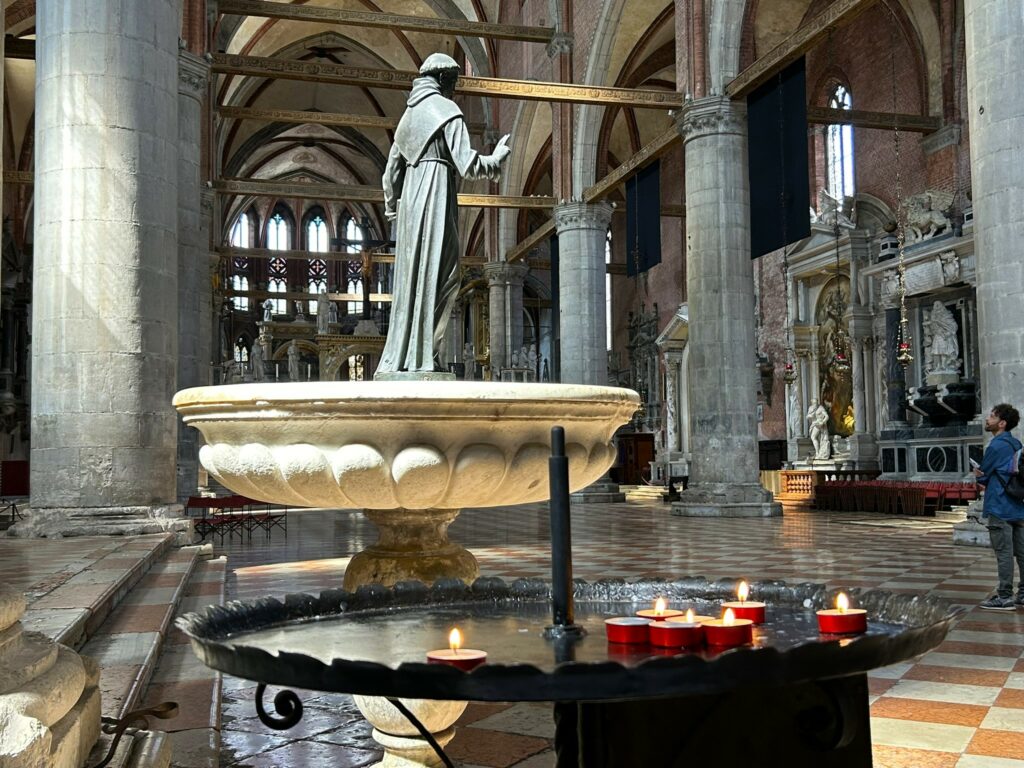
In loving memory …
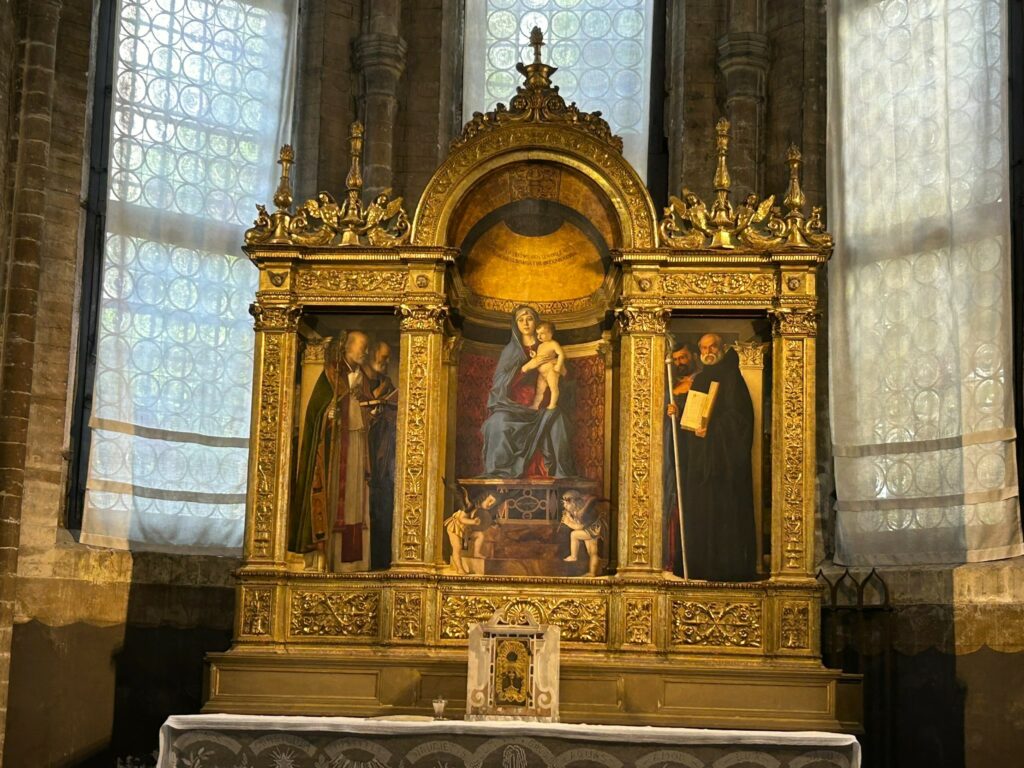
Giovanni Bellini, Madonna mit Kind zwischen den hl. Petrus, und Nikolaus, Benedikt und Markus, Sakristei
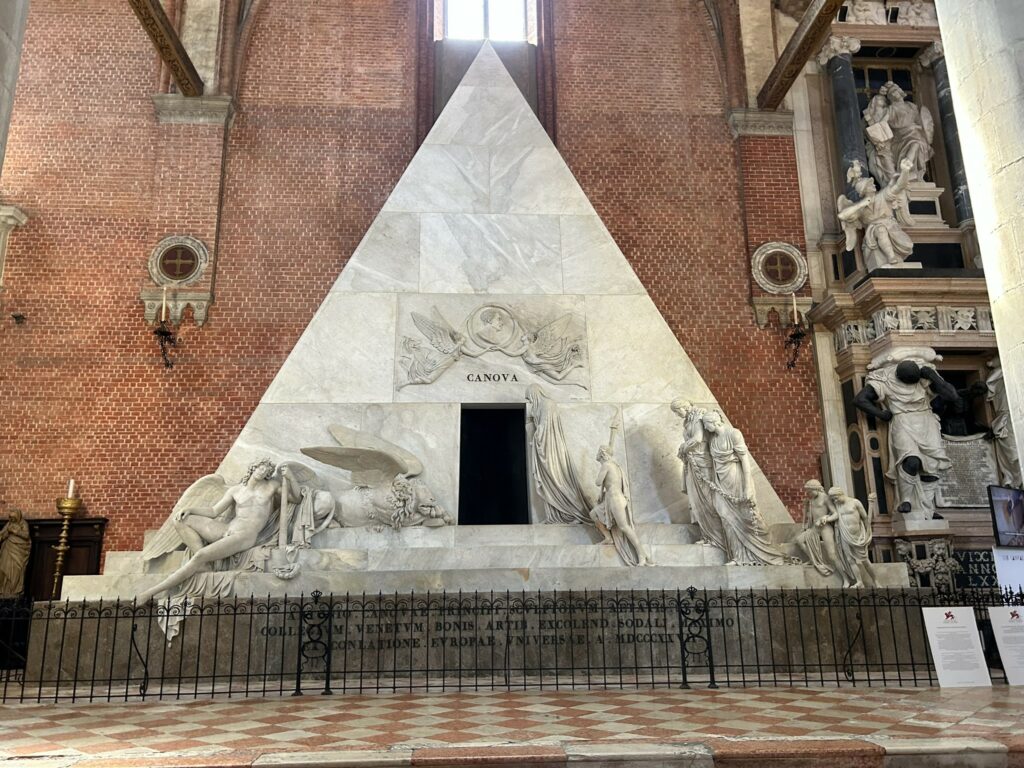
Denkmal für Antonio Canova
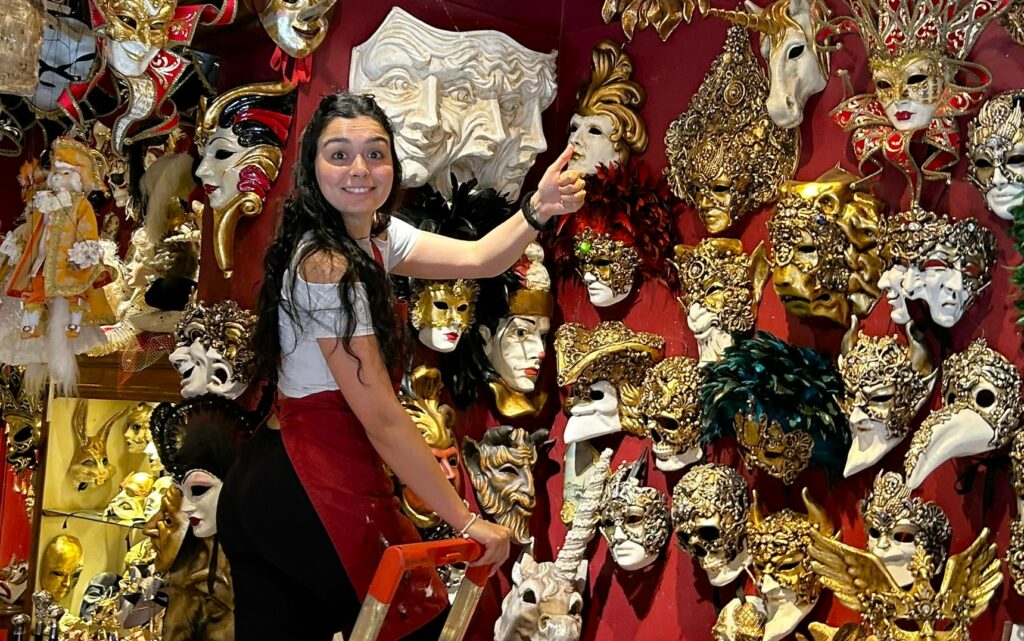
Stadt der Masken
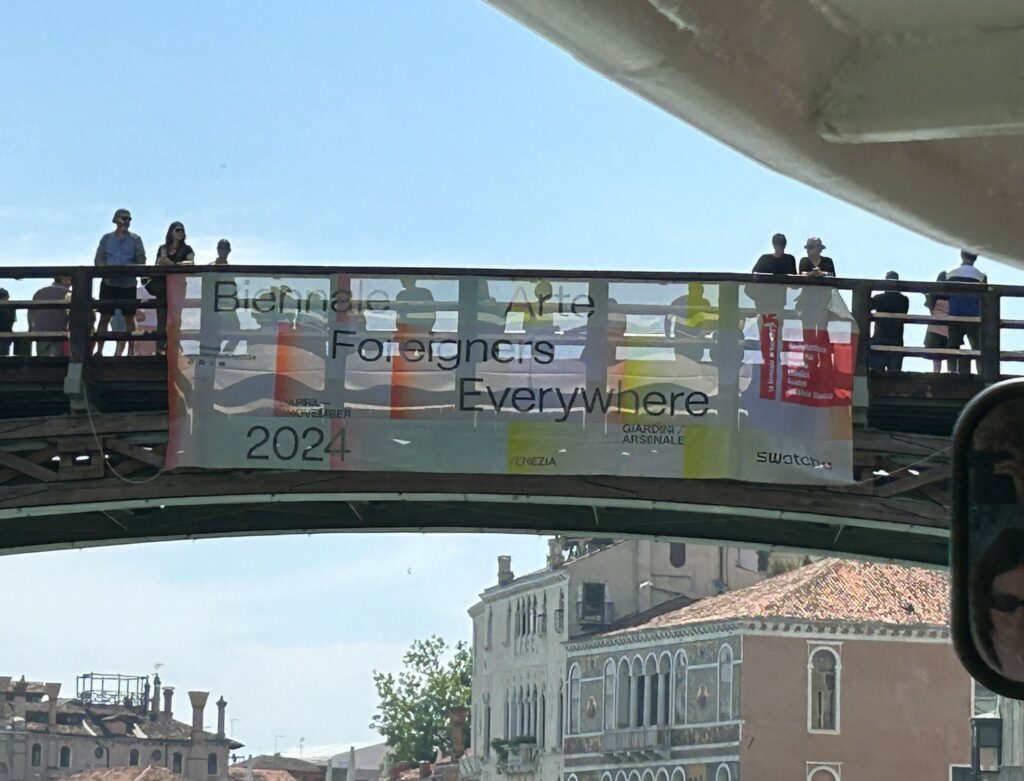
Die Brücke Ponte dell’Accademia in Venedig überspannt den Canal Grande und verbindet die Einzelinseln Santo Stefano und Accademia, den Campo S. Vidal mit dem Campo della Carità, die Contrade S. Vidal und S. Trovaso, sowie die Sestieri San Marco mit Dorsoduro. Ihren Namen verdankt sie den Gallerie dell’Accademia, der am Campo della Carità liegenden, bedeutendsten Gemäldesammlung Venedigs.
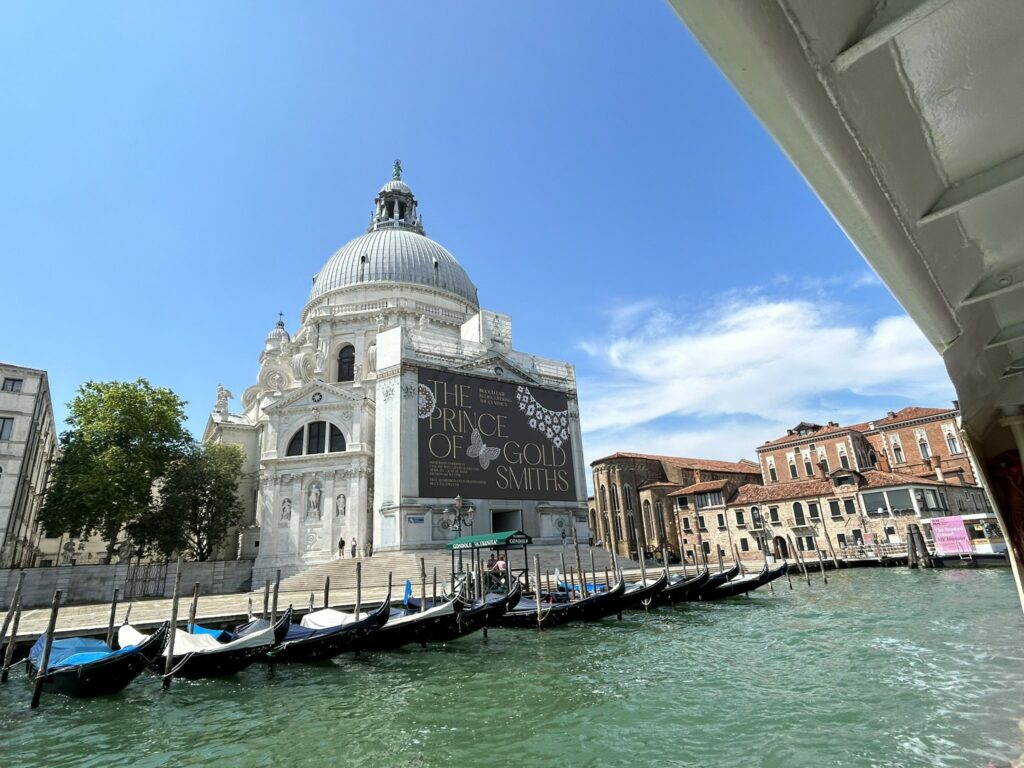
An exhibition on timeless art, craftsmanship techniques passed down from generation to generation, and classical models of beauty reinterpreted for our present times, in the suggestive city of Venice.
Unterwegs am Canale Grande
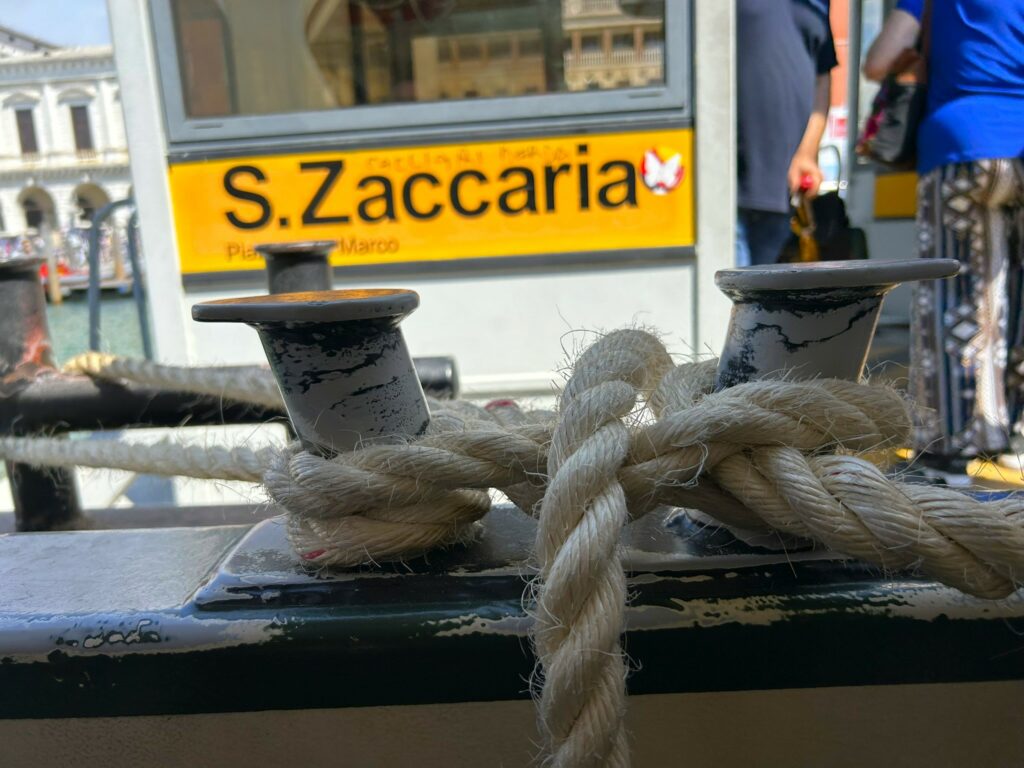
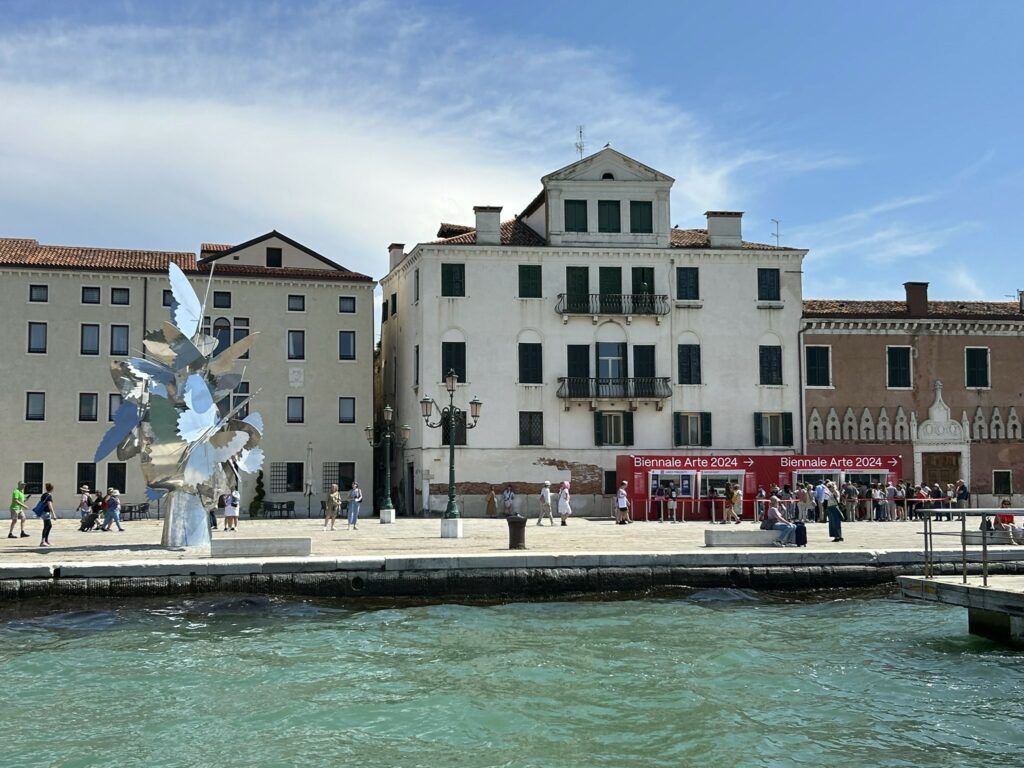
Besuch der Kunstbiennale, diesmal erstmals beginnend im Arsenale
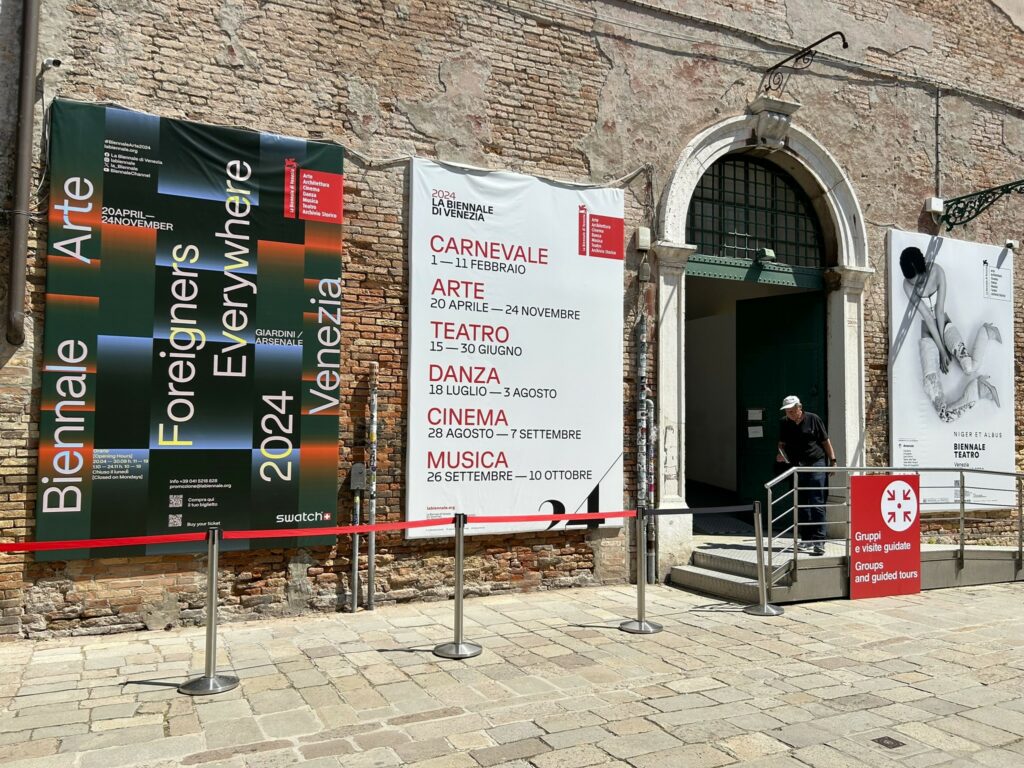
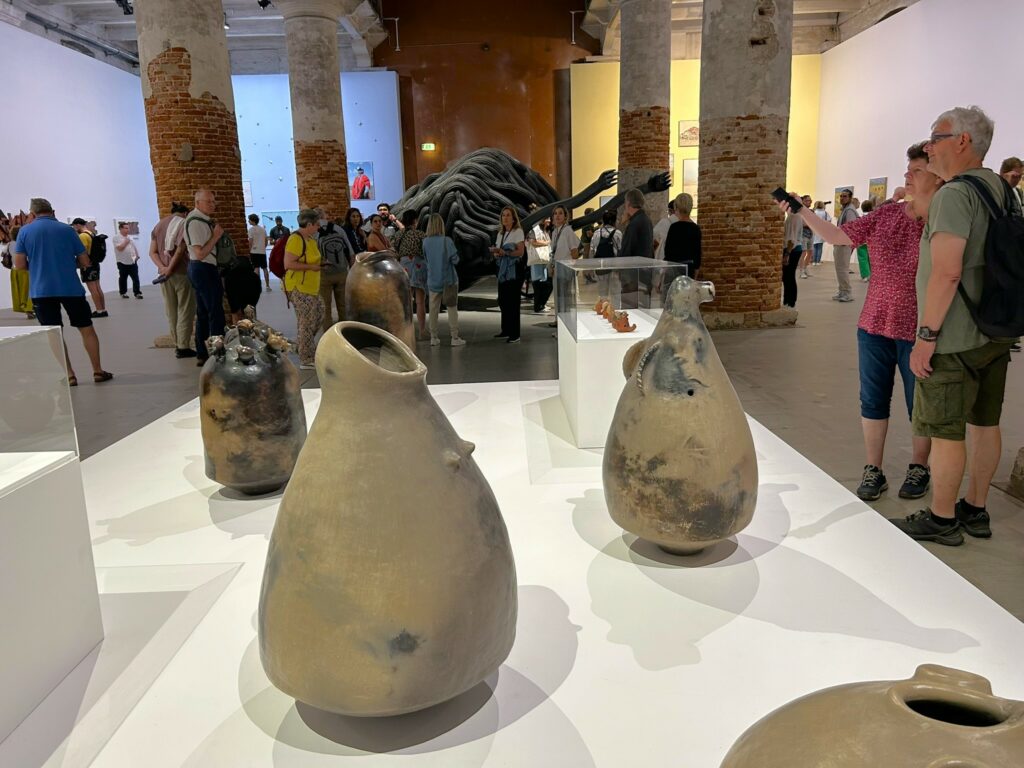
The Arsenale currently hosts the National Pavilions of Albania, Argentina, Chile, People’s Republic of China, Croatia, Georgia, Indonesia, Ireland, Italy, Republic of Kosovo, Latvia, Luxembourg, Former Yugoslav Republic of Macedonia, Malta, Mexico, New Zealand, Peru, Philippines, Singapore, Republic of Slovenia, Republic of South Africa, Tunisia, Turkey, and United Arab Emirates.
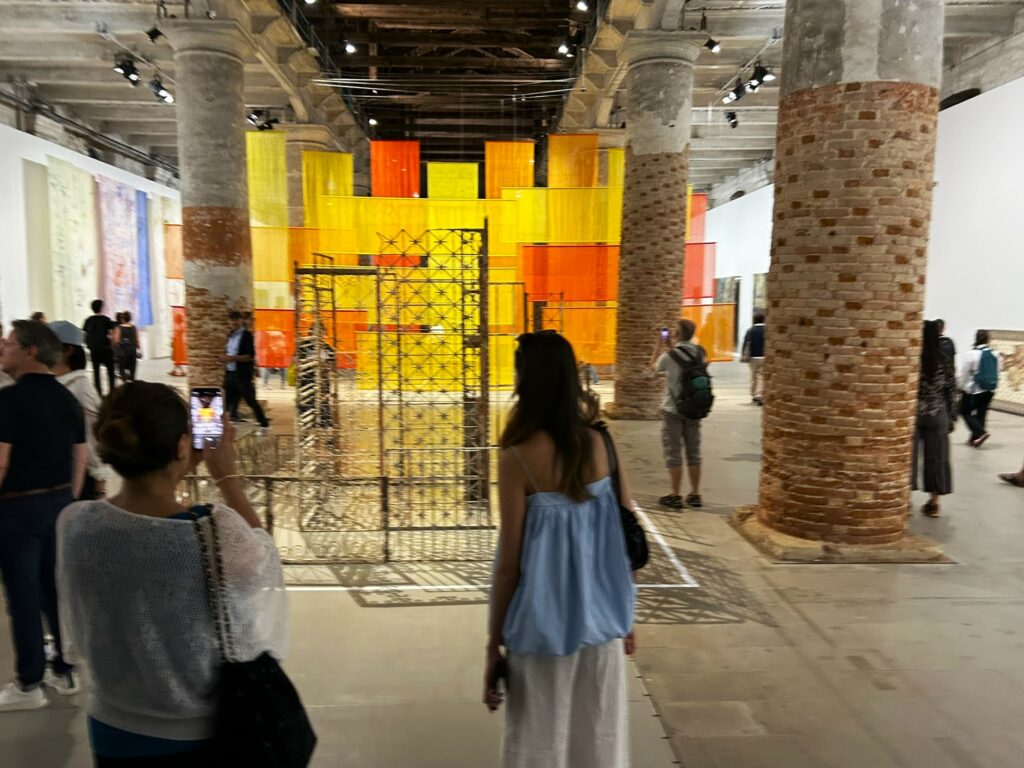
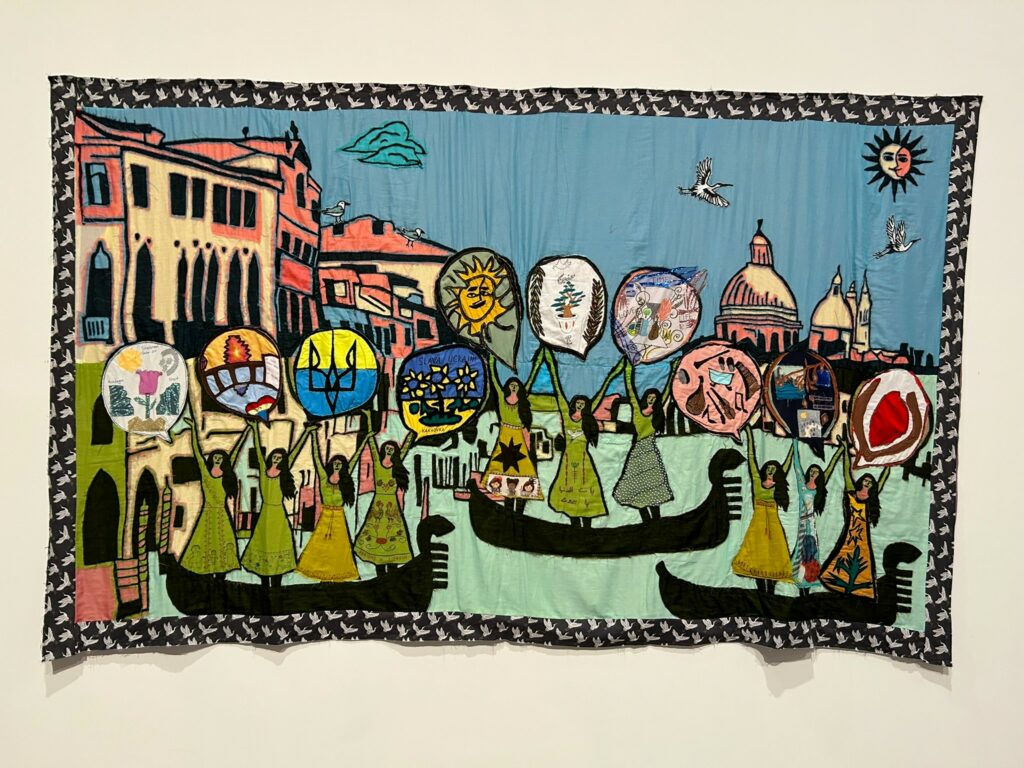
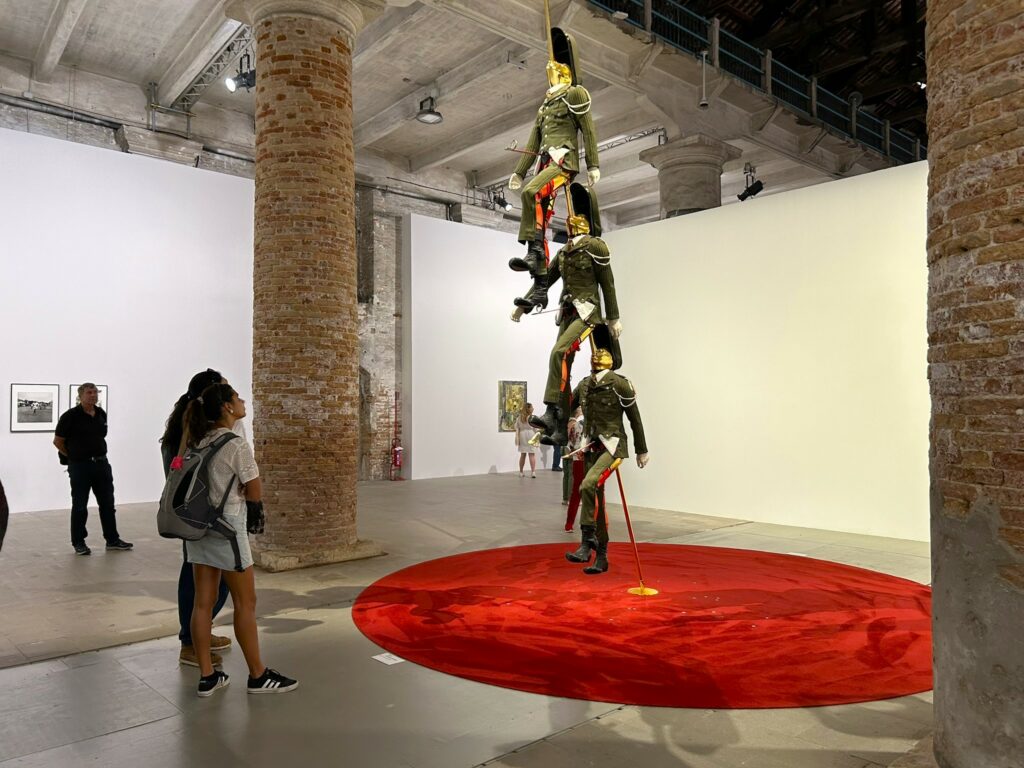
This is the first time the work of Bárbara Sánchez-Kane is presented at Biennale Arte.
—José Esparza Chong Cuy
BÁRBARA SÁNCHEZ-KANE – Mérida, Mexico, 1987
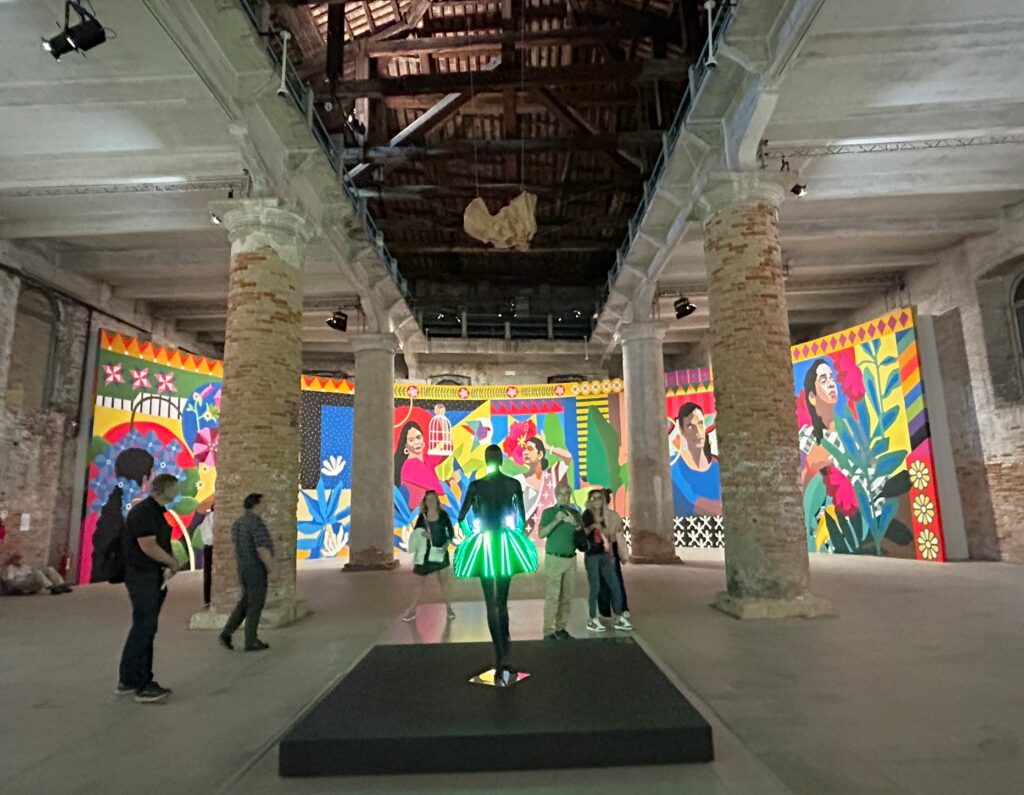
Aravani Art Project, India – Puppies, Puppies
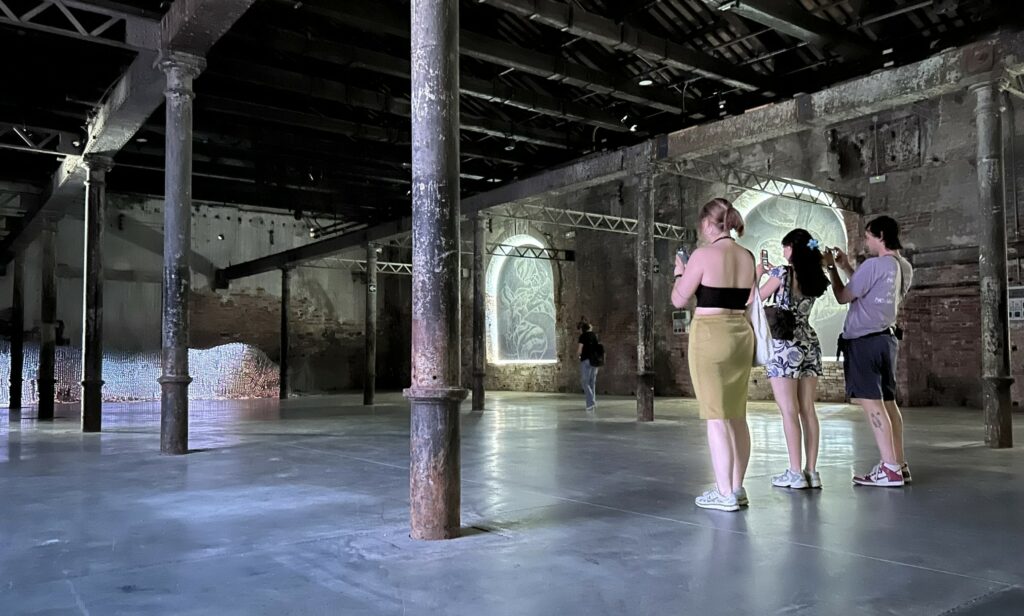
WangShui, Dallas
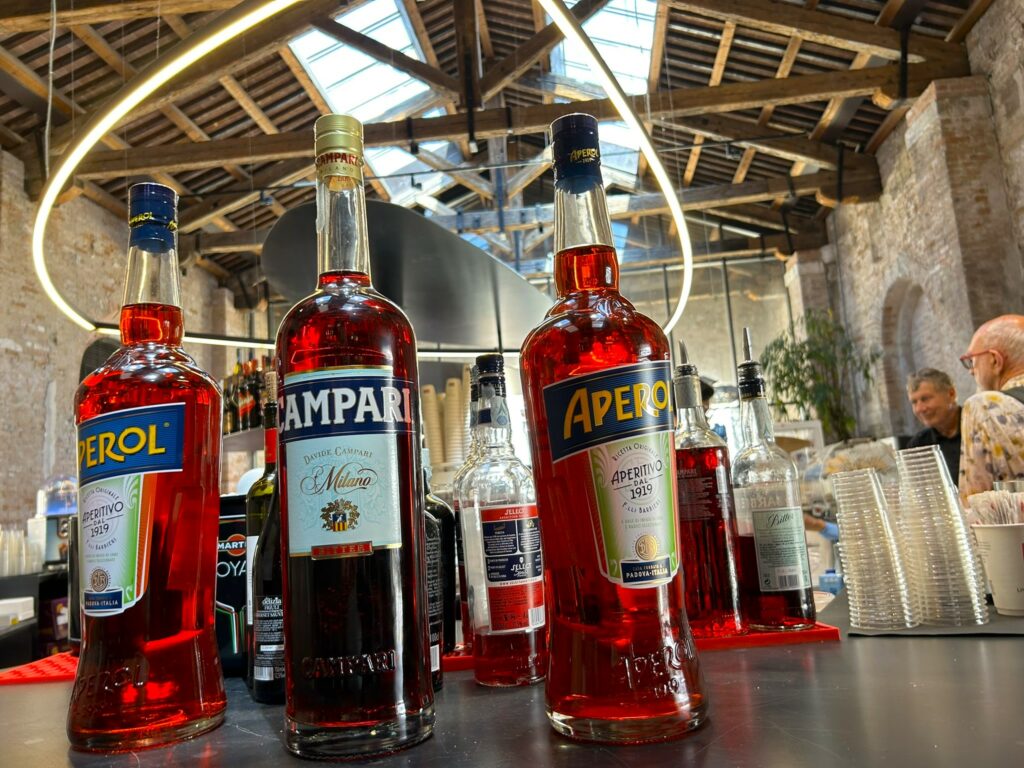
Kurze Doping Pause
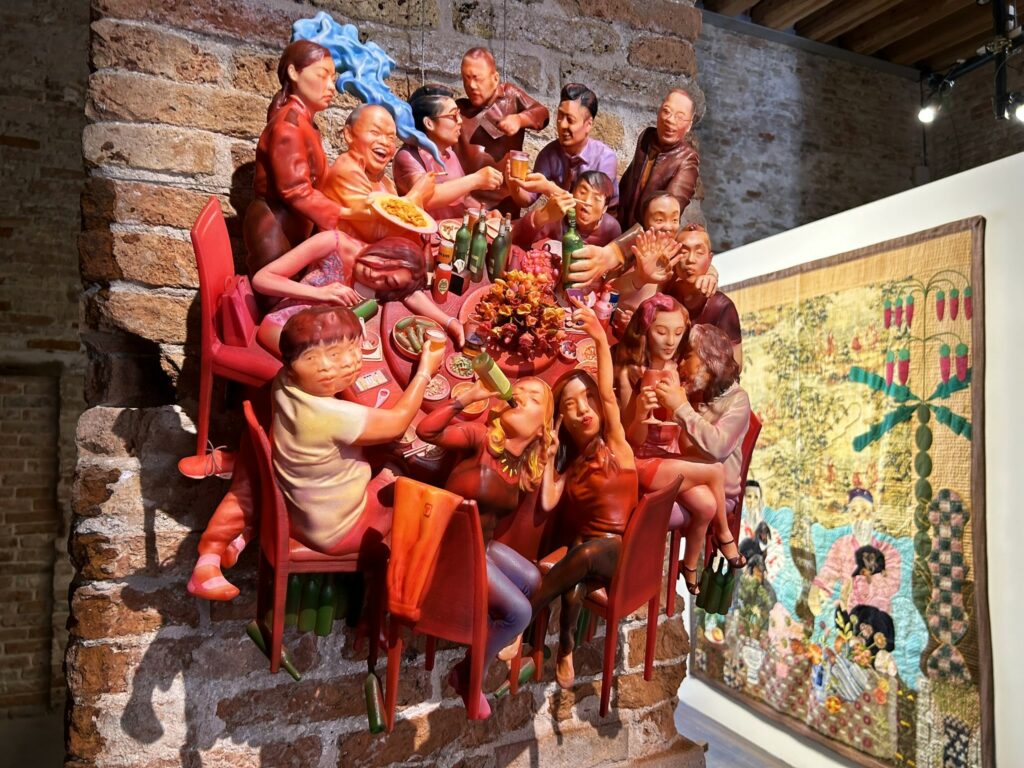
Swatch Art Peace Hotel
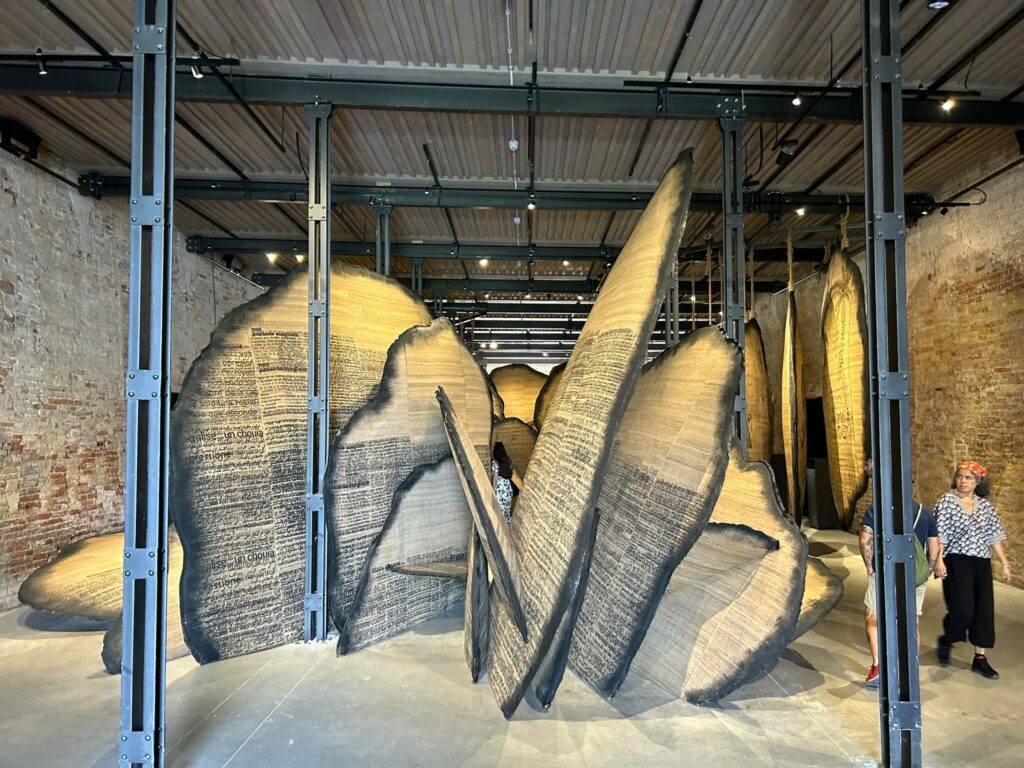
https://universes.art/de/biennale-venedig/2024/pavillons-arsenale/saudi-arabien
Shifting Sands. A Battle Song
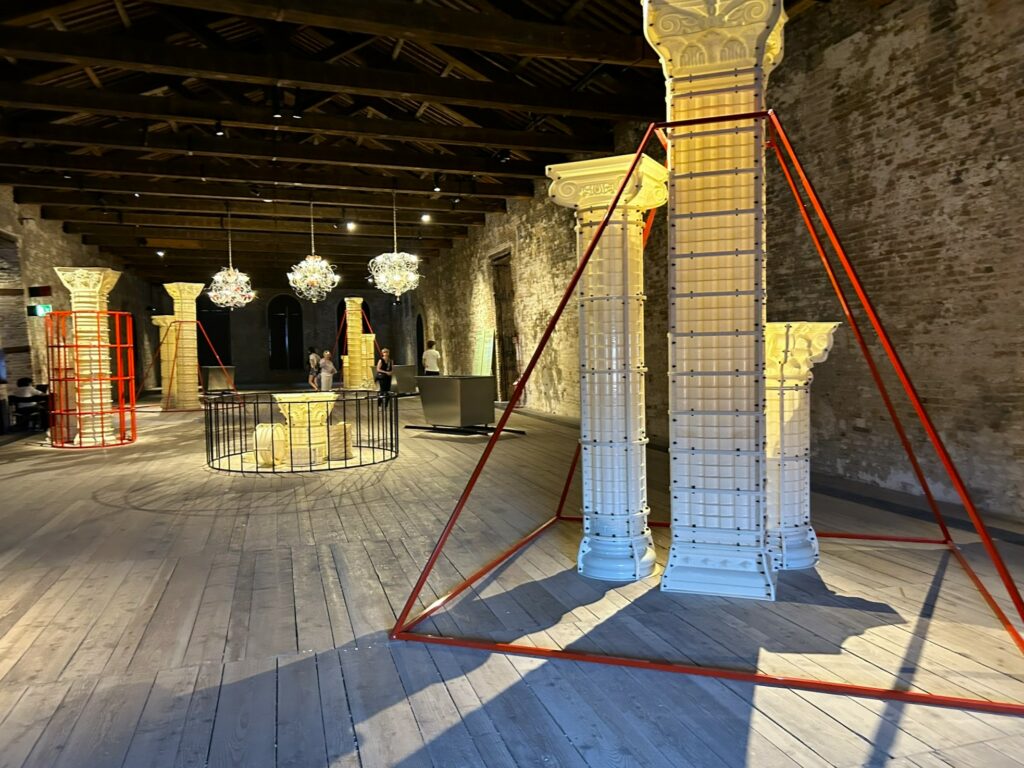
Für die Biennale von Venedig 2004 präsentiert der türkische Pavillon Hollow and Broken: A State of the World, eine ortsspezifische Installation von Gülsün Karamustafa, einer der einflussreichsten Künstlerinnen der Türkei. Die Ausstellung befindet sich im historischen Sale d’Armi des Arsenale und läuft vom 20. April bis zum 24. November. Karamustafas Installation lädt den Betrachter ein, sich mit den tragischen und turbulenten Realitäten einer Welt auseinanderzusetzen, die von Kriegen, Erdbeben, Migration und nuklearen Gefahren betroffen ist. Die Werke, die aus einer Verbindung von skulpturalen Arbeiten, der Premiere eines neuen Films und einer Klanginstallation bestehen, spiegeln seine Wahrnehmung der Welt als gebrochen und leer wider.
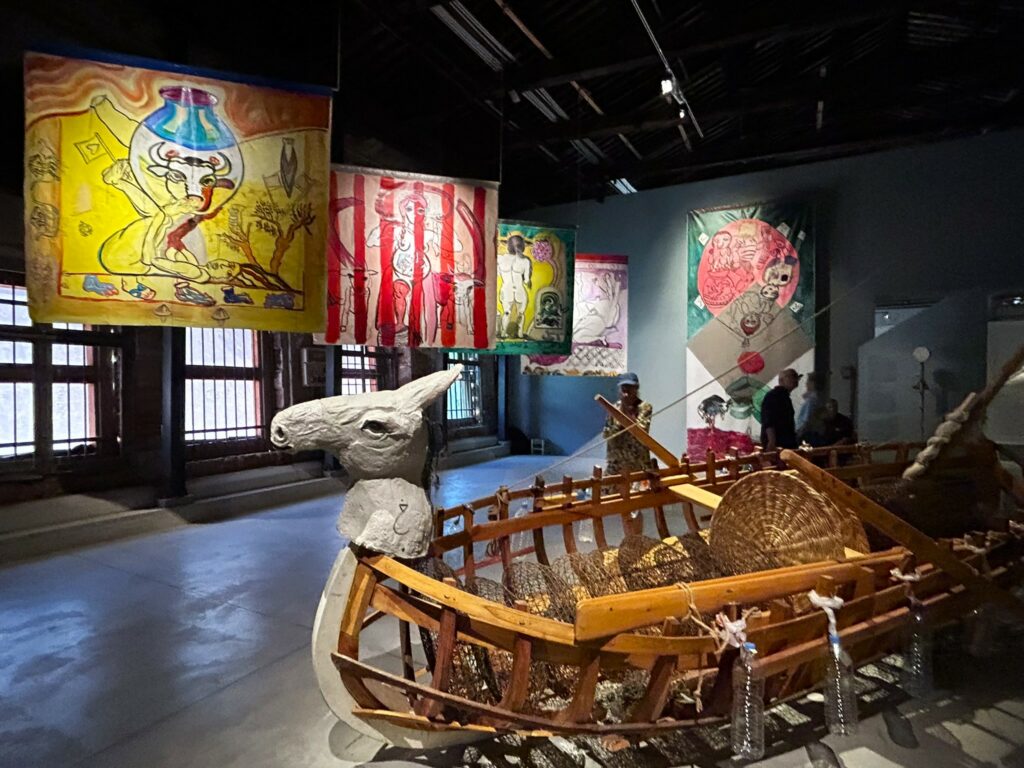
Lebanon
A Dance with her Myth, Mounira Al Solh
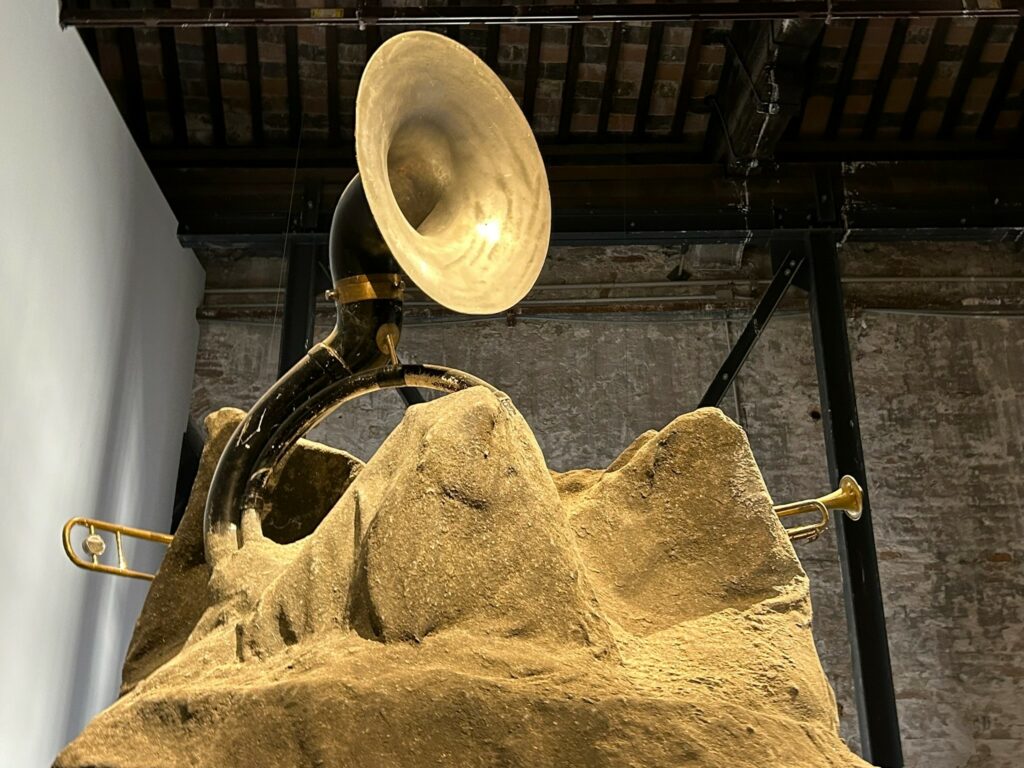
Mark Salvatus, Sa kabila ng tabing lamang sa panahong ito / Waiting just behind the curtain of this age, 2024
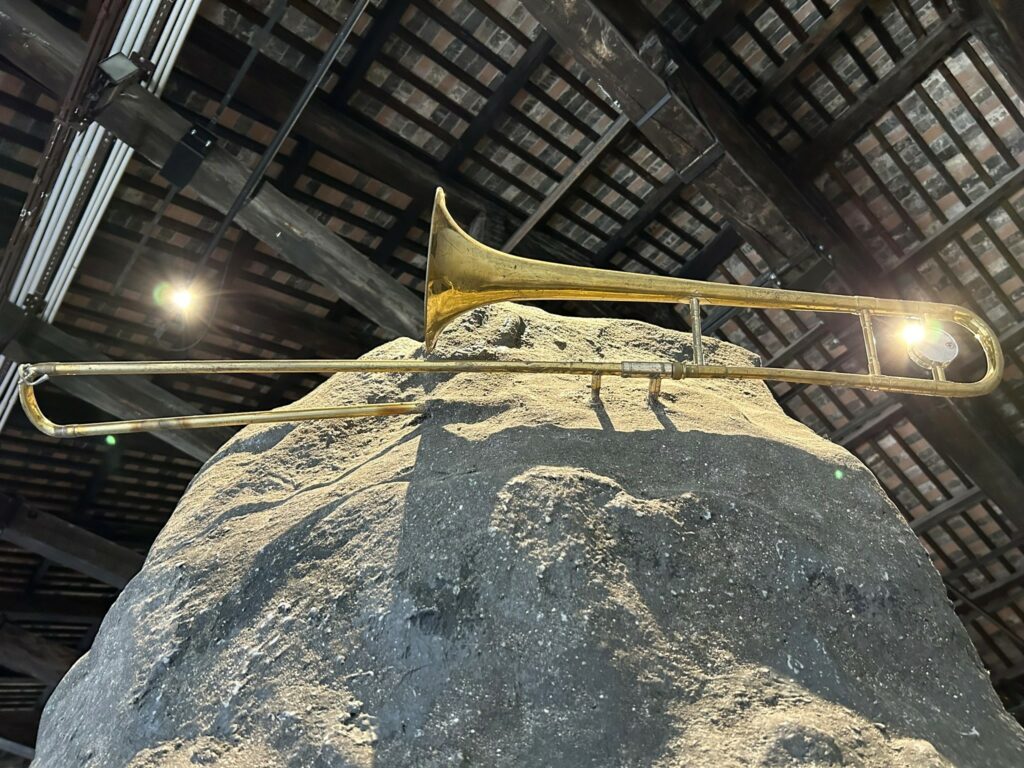
Mark Salvatus’s Philippines Pavilion, Sa kabila ng tabing lamang sa panahong ito / Waiting just behind the curtain of this age, might initially leave you grasping, too. Once you’ve finally made sense of the exhibition text (if you’re that type of gallery-goer), you, more purposefully, meander through a series of translucent curtains into the centre of the space, a clearing of sorts in which a film shows a series of musicians traversing the forested foothills of Mount Banahaw, an active volcano in the Philippines. Wide shots ingratiate us to the sublime landscape and secretive corners of undergrowth alike, the camera tracking toward the mountain with epic scale or the frame obscured by out-of-focus leaves or branches. One musician is lying on a moss-bed with a trumpet pressed to his chest; in a later shot, his instrument pokes out from behind a tree, and then back again, like a coy creature. In the room, we hear stabs of trumpet notes, played occasionally between piano-like notes, whispers and pops that come from speakers installed disorientingly around the space. Once in a while, a thunderous boom shakes the space, like thunder cracking or the volcanic cap being disturbed. Behind the dainty curtains a series of fibreglass boulders are plonked on the ground with trumpets protruding from their surface, as if wedged into concrete before it had set. It’s all a little bizarre, each work and sound a series of perspective-shifts or wrong-footings. The title is taken from the founder of a religious group who led a resistance movement against the Spanish Catholic church during the Spanish rule. And so we have these trumpets, musical instruments with their dichotomic histories as tools in communication for revolutionaries fighting against colonialism, and the inescapable historical background of the trumpet’s tone as pronouncements by colonial military regalia. Past and present, land and state, nature and human; confused, intertwined.

Philippines Pavilion

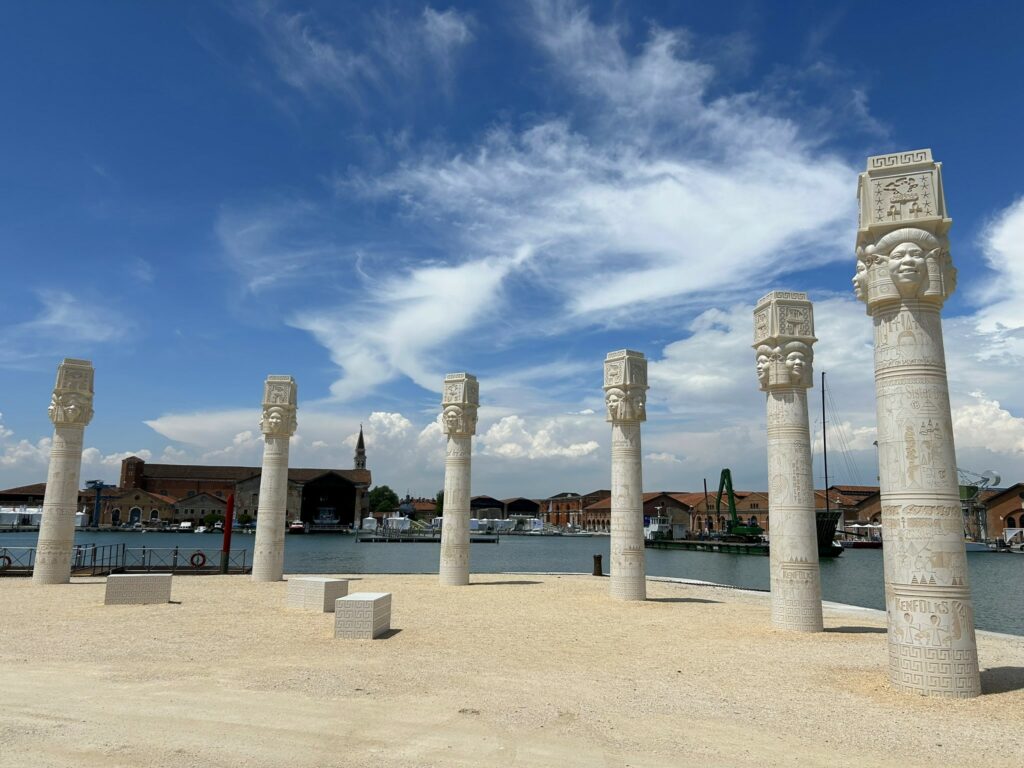
Installation von Lauren Halsey mit dem Titel Keepers of the krown

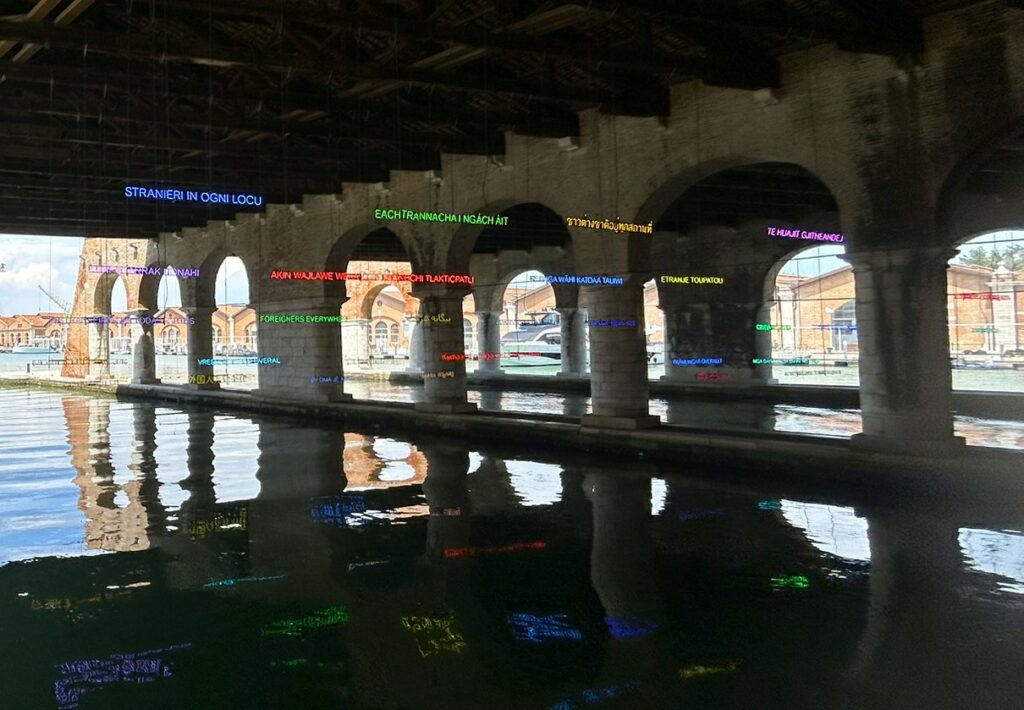
Stranieri Ovunque – Foreigners Everywhere, the title of the 60th International Art Exhibition of La Biennale di Venezia, is drawn from a series of works started in 2004 by the Paris-born and Palermo-based Claire Fontaine collective. The works consist of neon sculptures in different colours that render in a growing number of languages the words “Foreigners Everywhere”. The phrase comes, in turn, from the name of a Turin collective who fought racism and xenophobia in Italy in the early 2000s.
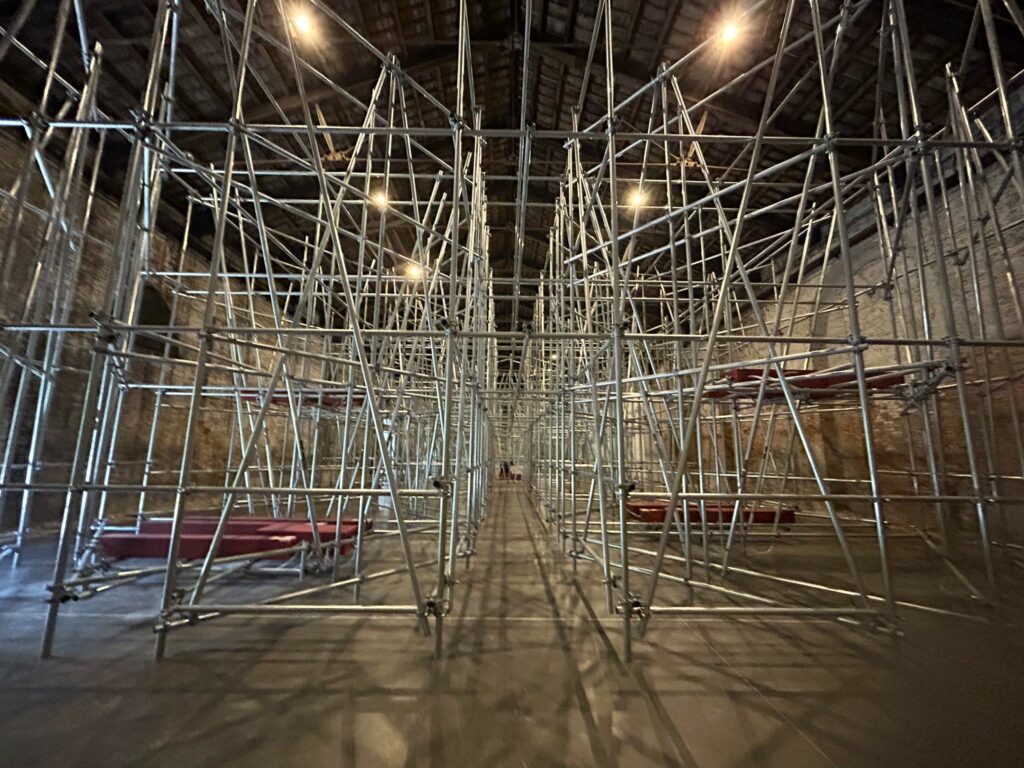
Massimo Bartolini
Italy has the biggest pavilion in the Arsenale but how do you make the most of it? This year Massimo Bartolini fills up the over-generous space with sound—well, sound and lots of scaffolding.
The scaffolding forms an industrial version of a garden maze. At its centre, the water in the pool is agitated by a wave, the heartbeat of an organic blob. Handmade rectangular organ pipes, laid on their sides like coffins, play a new piece of music (by Caterina Barbieri and Kali Malone), which evokes both the peace and the terror of religious music. In the garden outside, a haunting piece by the British composer Gavin Bryars emanates from hidden speakers.
There isn’t much to see in the Italian pavilion—but after a synapse-dazzling day in the Arsenale, this comes as a relief. This is a rare space in the Biennale for rest, contemplation and introspection.
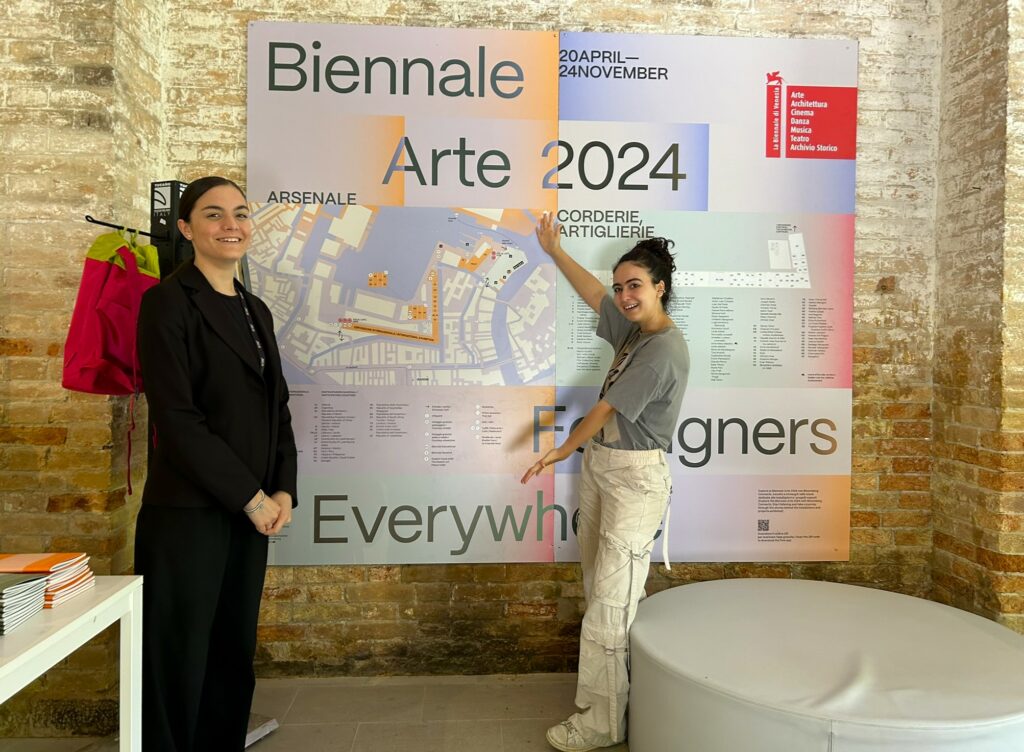
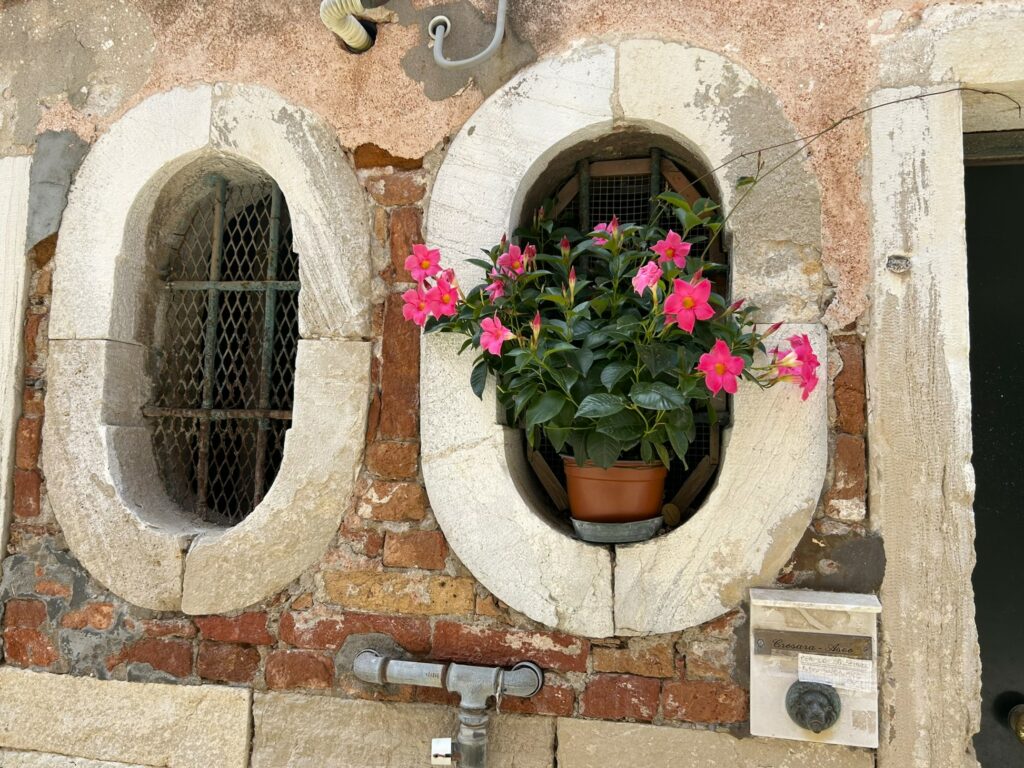
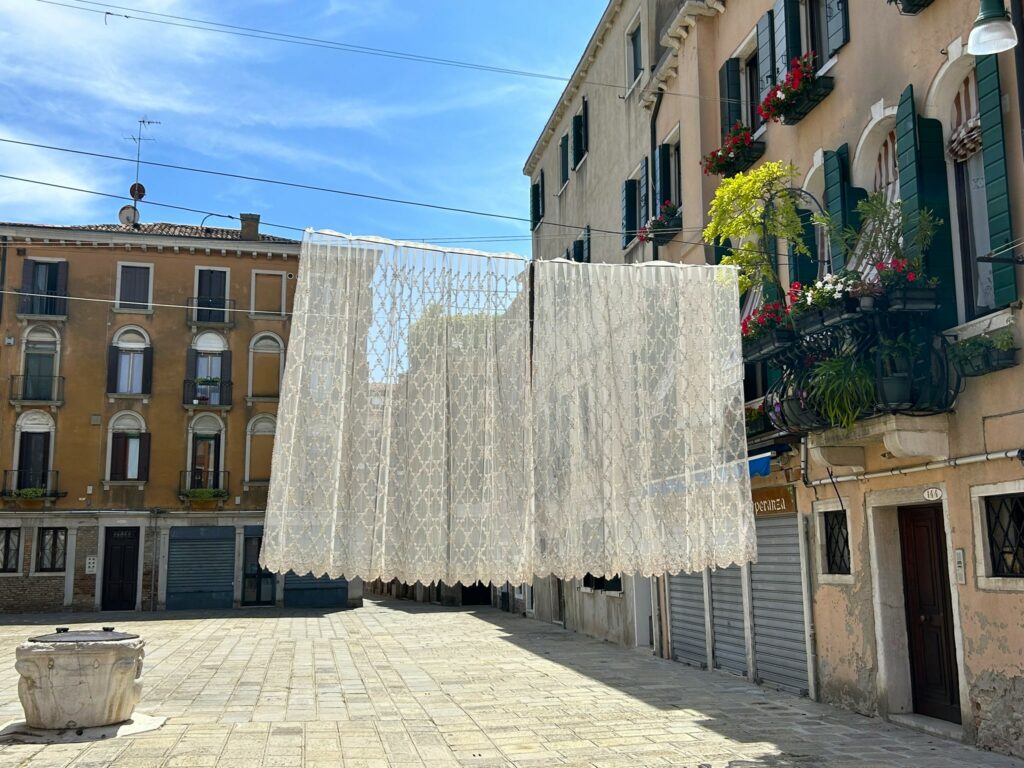
Vorhang auf für die Giardini

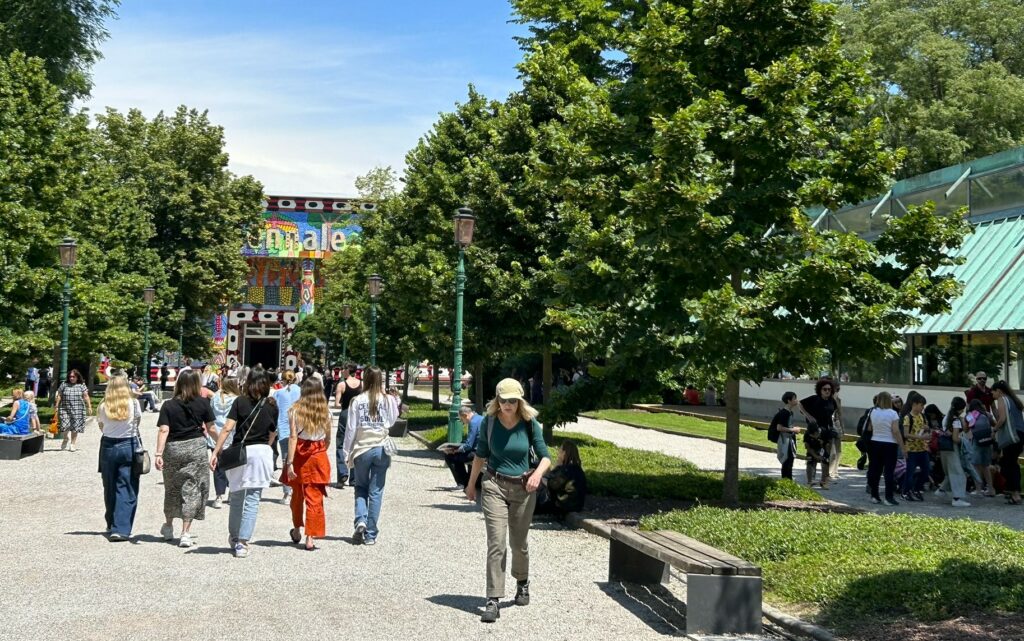

Venice Biennale of Art 2024, Sandra Gamarra Heshiki, Pinacoteca Migrante, Spanish Pavilion, Giardini
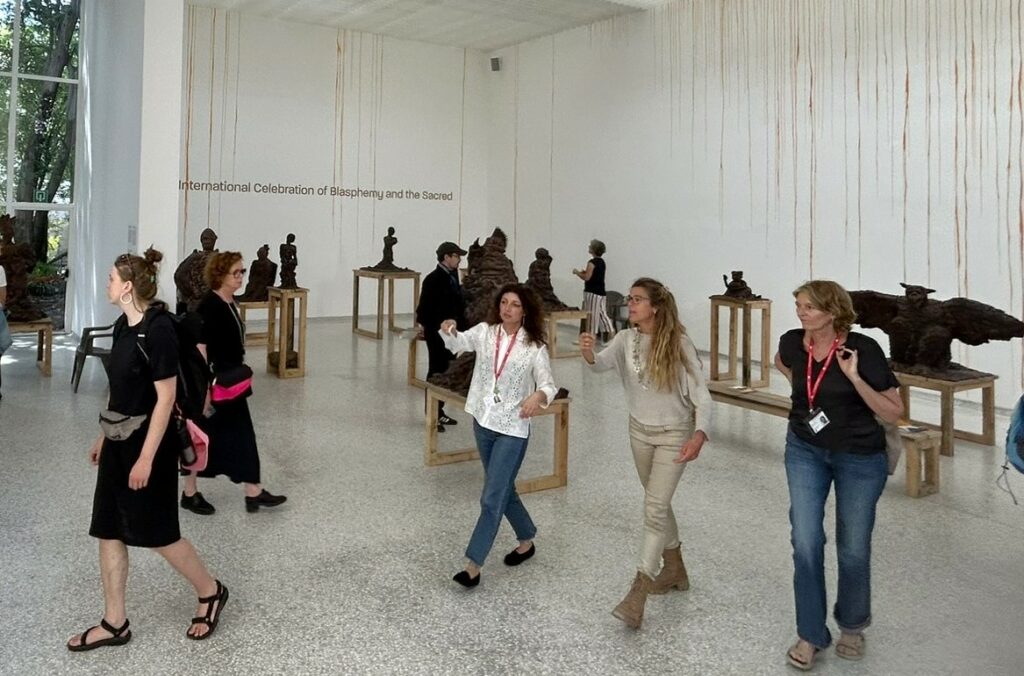
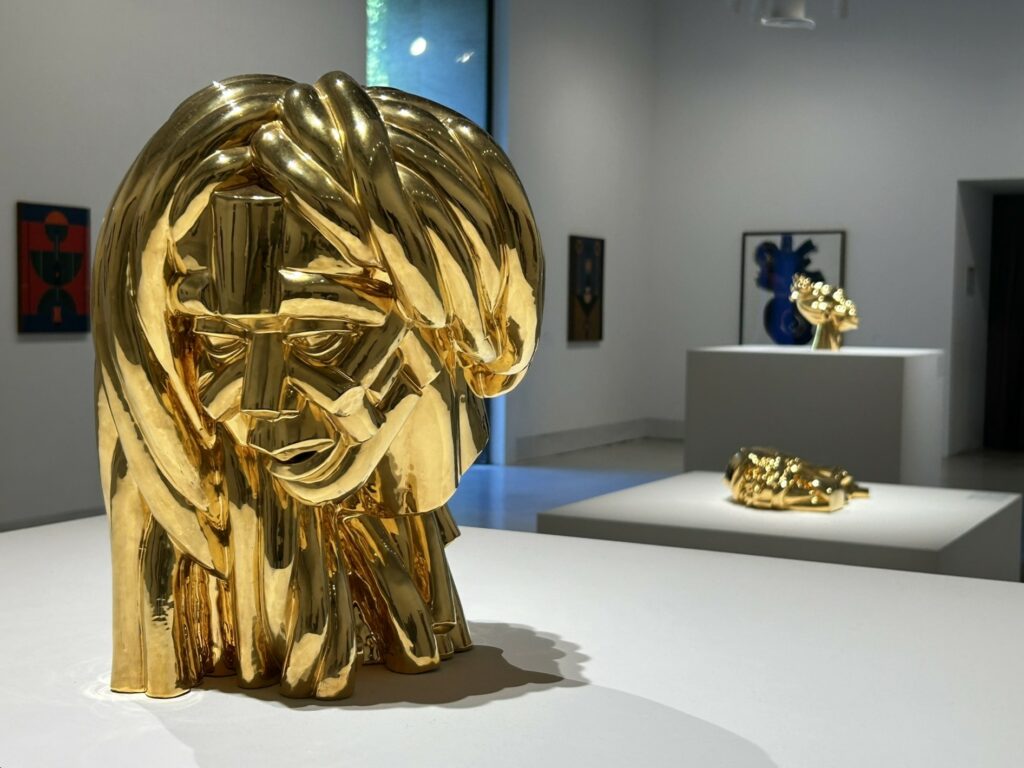
Victor Fotso Nyie was born in Cameroon, but lives in Faenza, Italy.
His sculptures, with their African lines, are made of clay coated with gold after the third firing.
Three of his sculptures were shown at the Venice Biennale.
“Malinconia” is a tribute to one of her sisters who is standing in front of a mirror.
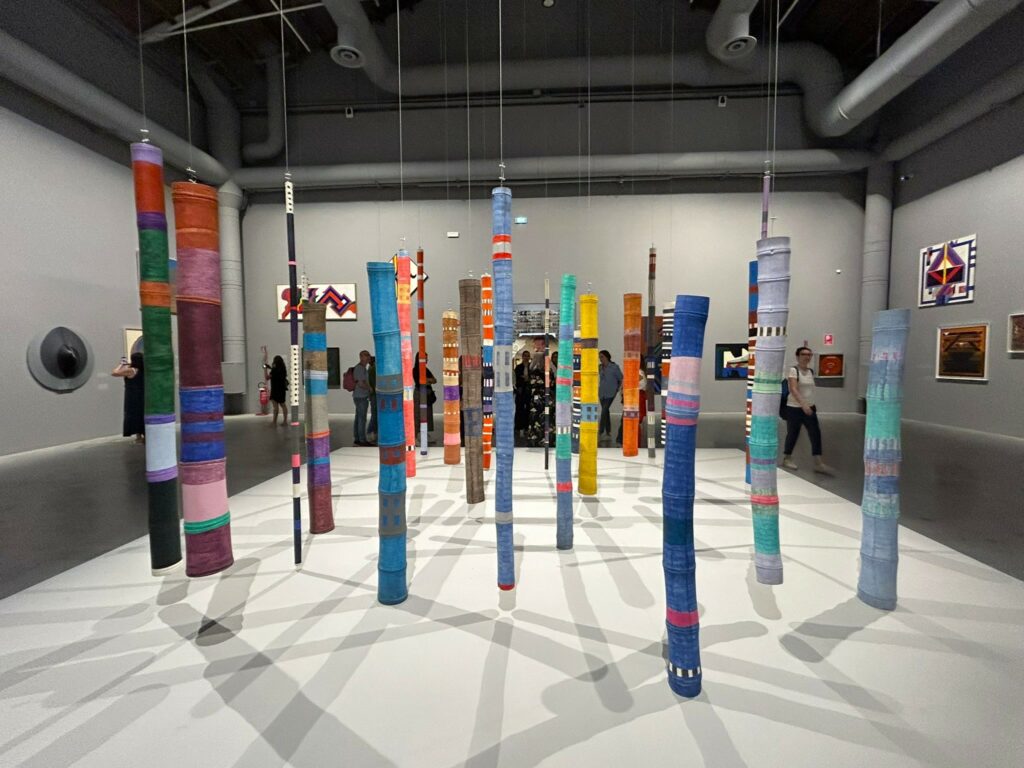
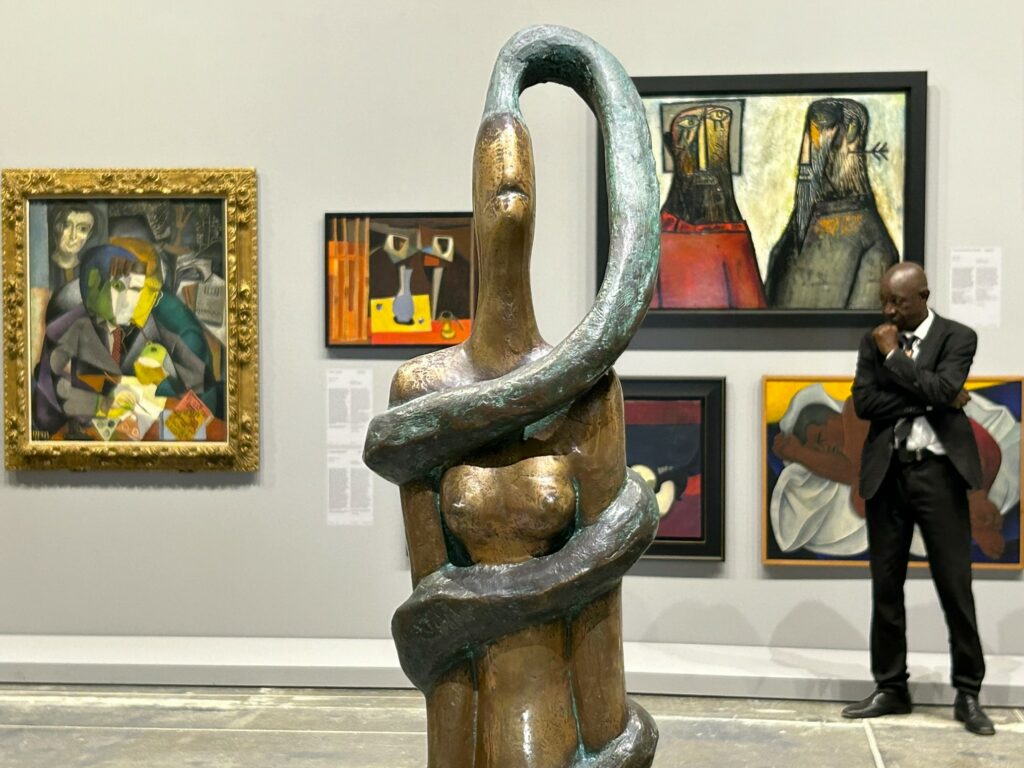
«The Nucleo Storico gathering works from 20th century Latin America, Africa, the Middle East and Asia. Much has been written about global modernisms and modernisms in the Global South, and a number of rooms will feature works from these territories, much like an essay, a draft, a speculative curatorial exercise that seeks to question the boundaries and definitions of modernism. We are all too familiar with the histories of modernism in Euroamerica, yet the modernisms in the Global South remain largely unknown. […]. European modernism itself travelled far beyond Europe throughout the 20th century, often intertwined with colonialism, and many artists in the Global South traveled to Europe to be exposed to it […].»
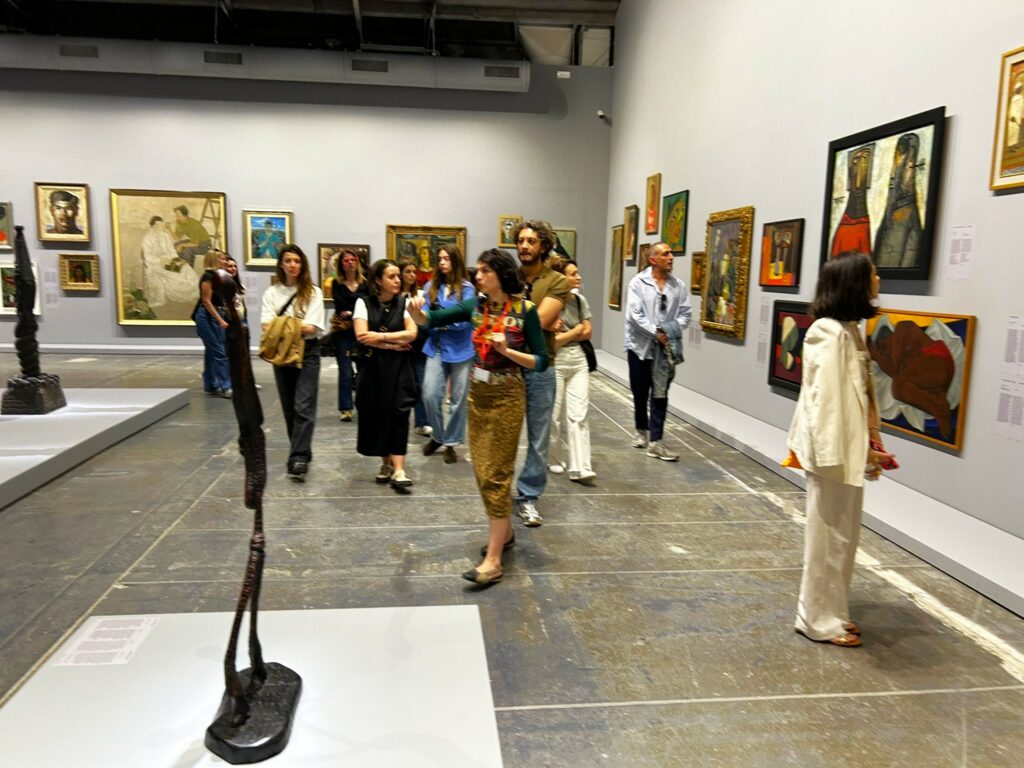
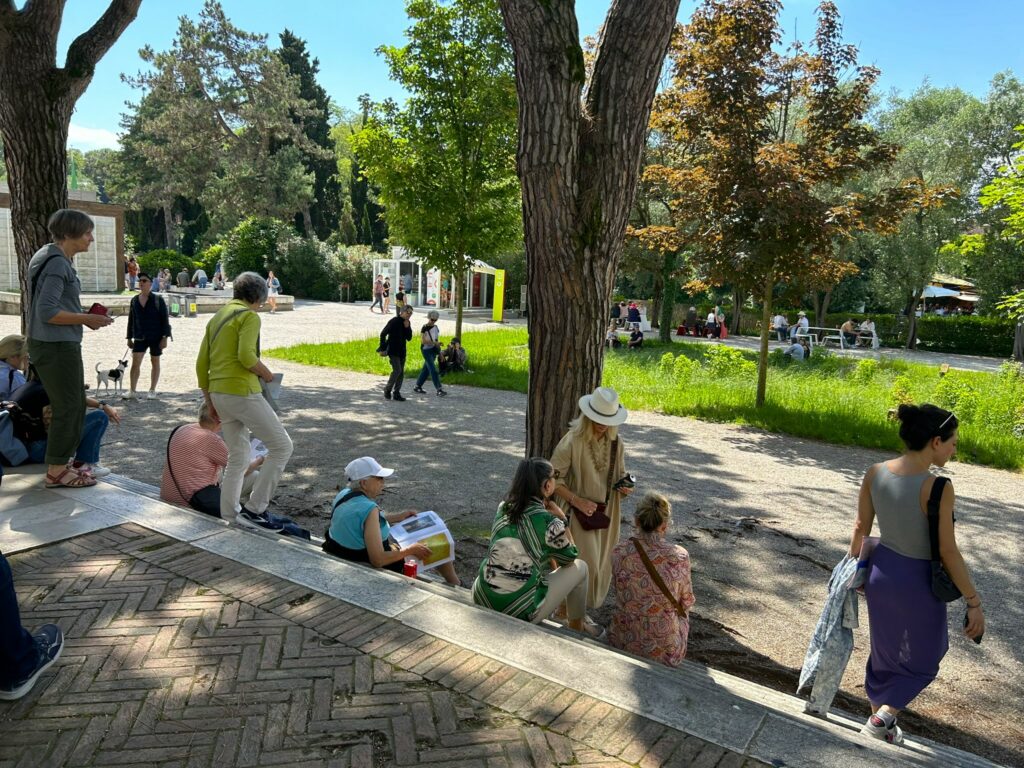
Unterwegs zum österreichischen Beitrag 2024:
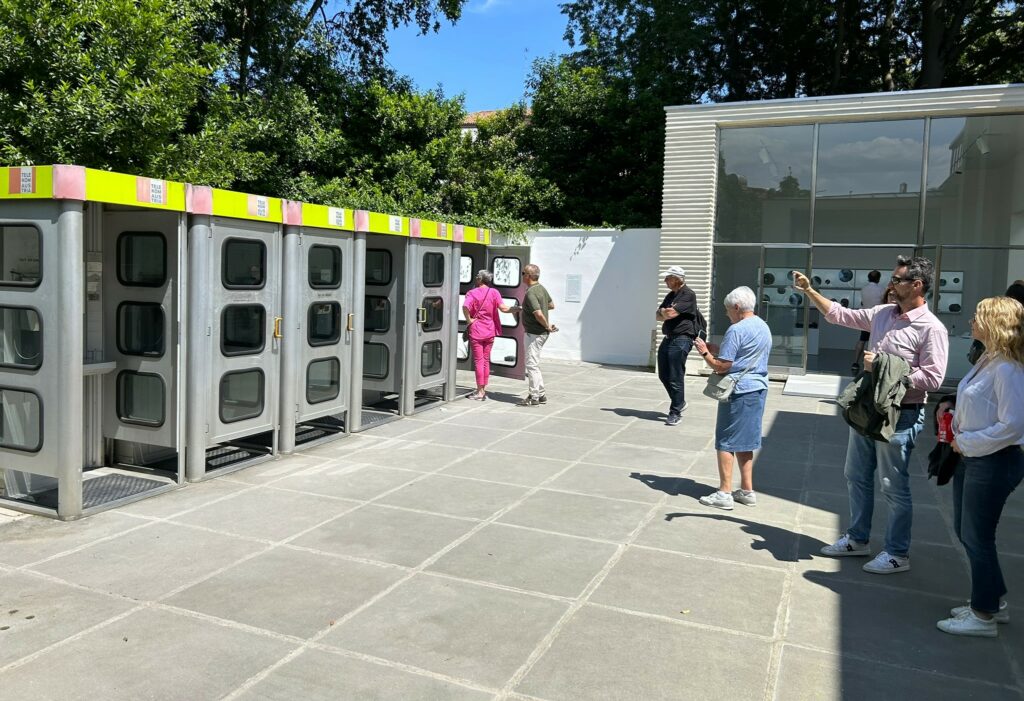
Das Readymade Untitled (Telephone Booths) (2024) im Innenhof des Pavillons besteht aus einer Reihe von Originaltelefonzellen aus dem österreichischen Flüchtlingslager Traiskirchen. Mit diesen sechs auf den ersten Blick unscheinbaren Telefonapparaten wurden angeblich die meisten internationalen Anrufe in ganz Österreich getätigt. An den Wänden stehen Notizen von Asylsuchenden. Die Zellen fungieren als Kapseln eines Spektrums an Gefühlen – sie weisen auf die Unsicherheit, aber auch die Hoffnung von Menschen auf der Flucht hin, die ihr Zuhause hinter sich gelassen haben und nicht wissen, was als Nächstes passieren wird. 1989 benutzte Jermolaewa genau dieselben Telefonzellen, um ihre Familie in Leningrad zu verständigen, dass sie im Westen angekommen war. Durch den Mobilfunk obsolet geworden, wurden die Apparate in Traiskirchen erst kürzlich abgebaut. In den Giardini haben sie nun ein zweites Leben bekommen: Die Telefonzellen sind funktionstüchtig und können von den Besucher:innen benutzt werden.
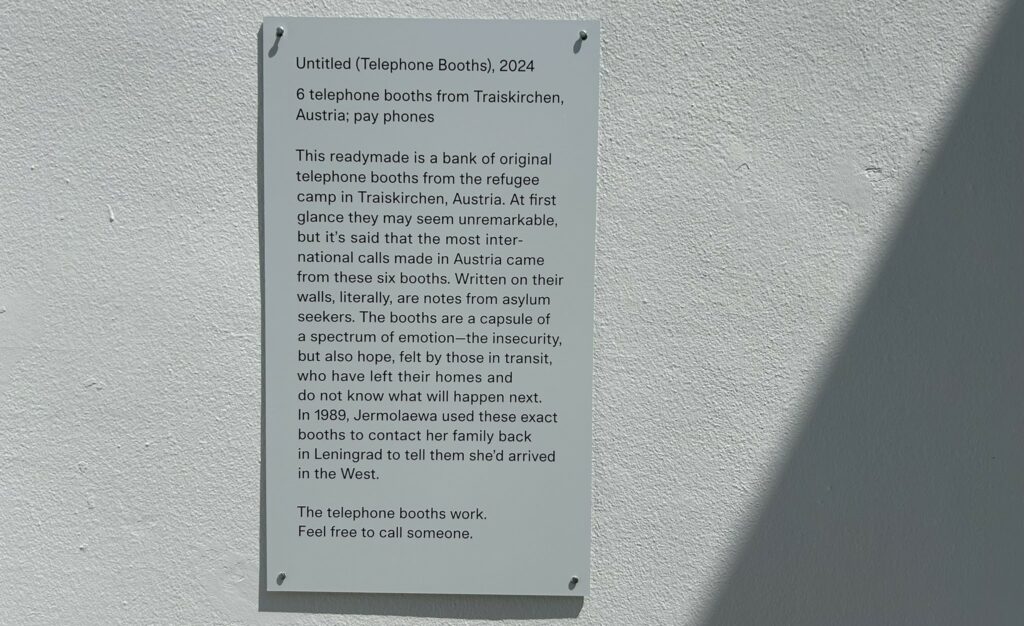
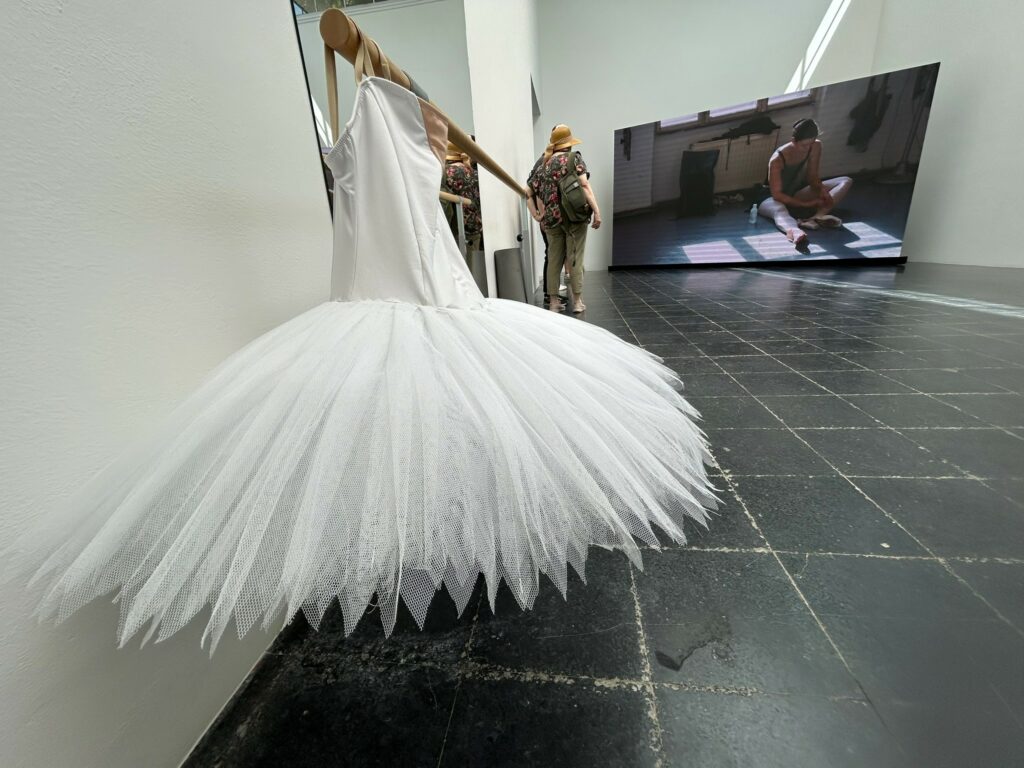
For its pavilion at Biennale Arte 2024, Austria presents conceptual artist Anna Jermolaewa. In her work, the artist — born in Leningrad (USSR) and living in Vienna since 1989 — proves to be an astute observer of human coexistence, its social conditions and political requisites. For the Austrian contribution, Jermolaewa draws an arc from her personal experience of migration as a political refugee to signifiers of nonviolent resistance against authoritarian regimes. In Rehearsal for Swan Lake, made in collaboration with Ukrainian choreographer Oksana Serheieva, Jermolaewa references a memory from her teenage years. In times of political unrest, for instance the death of a head of state, Soviet television replaced their regularly scheduled broadcast with Tchaikovsky’s Swan Lake in a loop for days. In Soviet cultural memory, the famous ballet became code for a change in power. Jermolaewa and Serheieva turn the ballet from a tool of censorship and distraction into a form of political protest — here, the dancers rehearse for regime change in Russia.
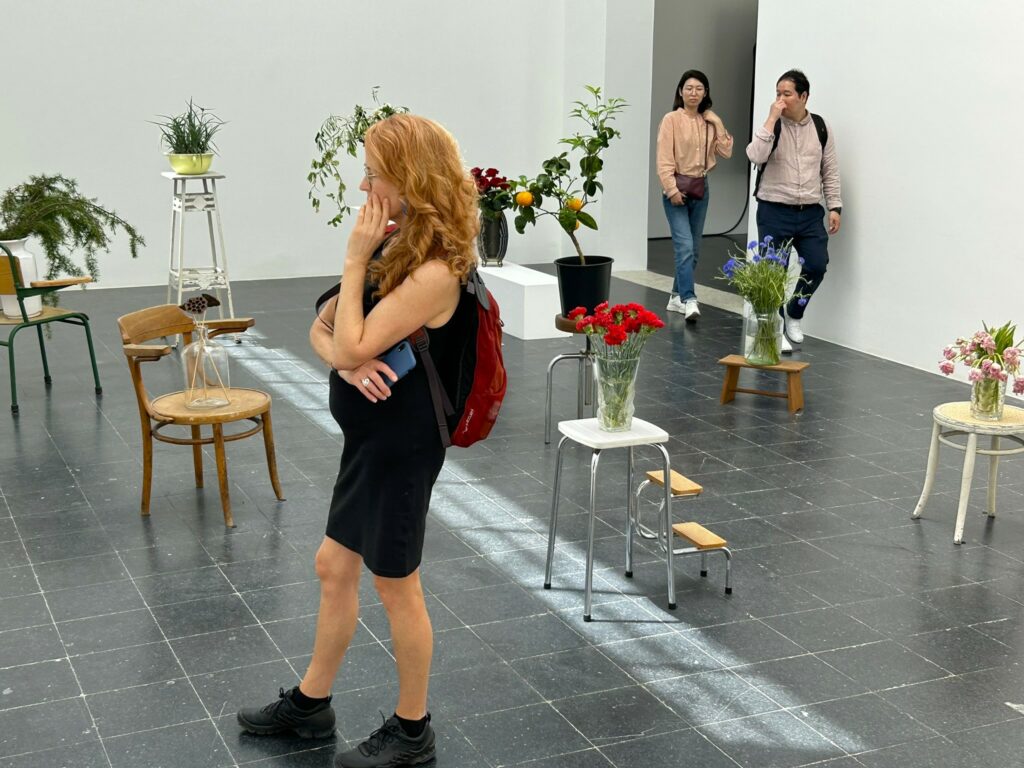
The Penultimate (2017) besteht aus einer Serie von Pflanzenarrangements: Nelken, Rosen, Tulpen, Kornblumen, Lotus, Safran, Jasmin, eine Zeder und ein Orangenbäumchen. Diese beziehen sich auf sogenannte, meist friedliche »Farbrevolutionen«, Volksaufstände, für die bestimmte Farben und Pflanzen als Symbole oder Bezeichnungen dienten. Mit roten Nelken hieß Portugal 1974 einen Militärputsch gegen die Diktatur willkommen.
Danach wurden 2003 in der georgischen Rosenrevolution und 2007 in der kirgisischen Tulpenrevolution Blumen als Symbole für die Proteste verwendet. Ebenso von diversen Medien als »Farbrevolutionen« charakterisierte Aufstände: 2005 die Zedernrevolution Libanons, Tunesiens Jasminrevolution 2010 und die Lotusrevolution in Ägypten 2011. Die ukrainische Orange Revolution in 2004, die Safranrevolution in Myanmar 2007 und die fehlgeschlagene Kornblumenrevolution in Weißrussland 2006, deren Namen auf die jeweiligen Farben zurückzuführen sind, werden hier mit der entsprechenden Pflanze dargestellt. Als Stillleben präsentiert, gemahnen die Pflanzen in der Installation daran, was undemokratische Regime am meisten fürchten: einen vom Volk ausgehenden Umsturz.
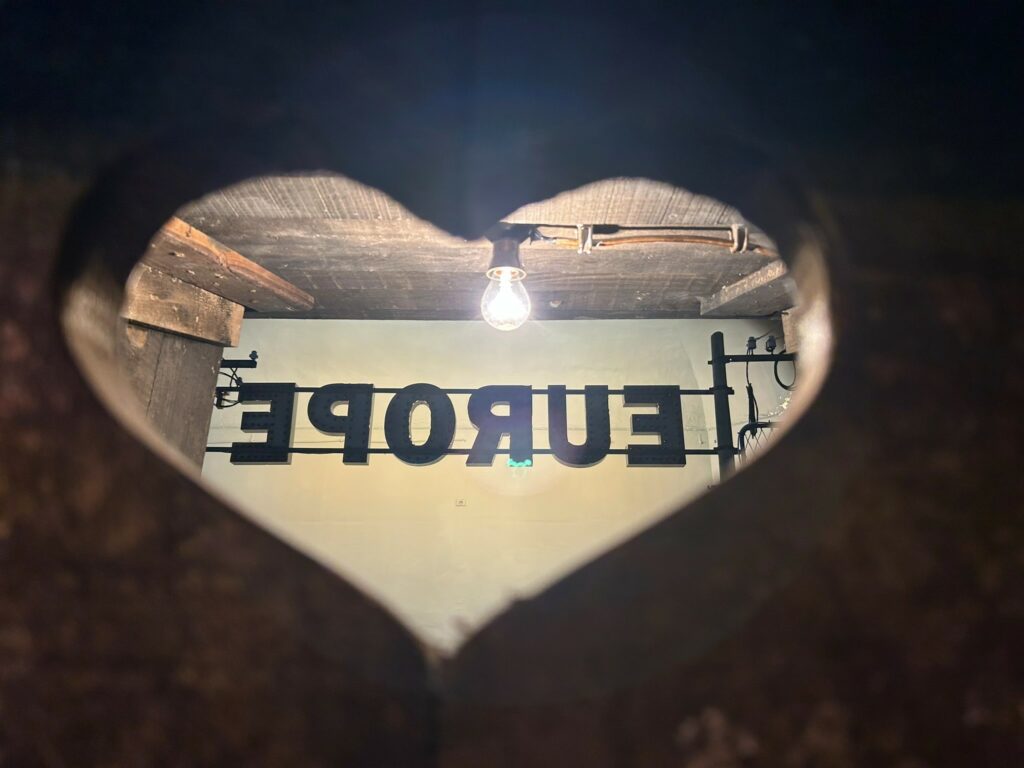
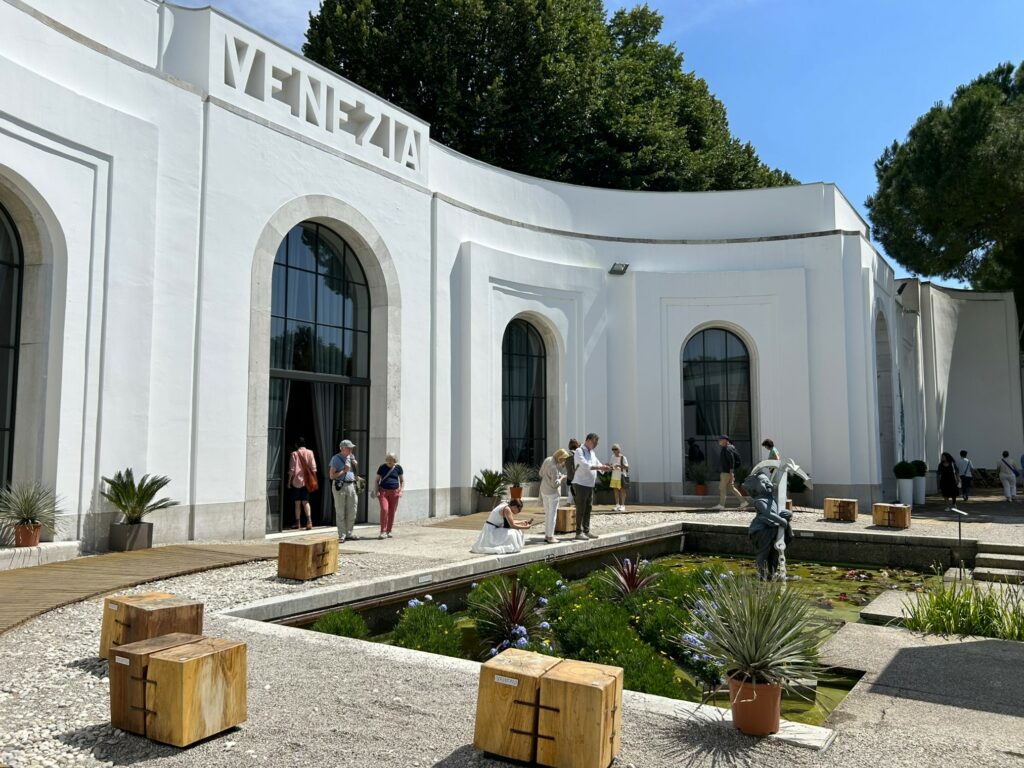
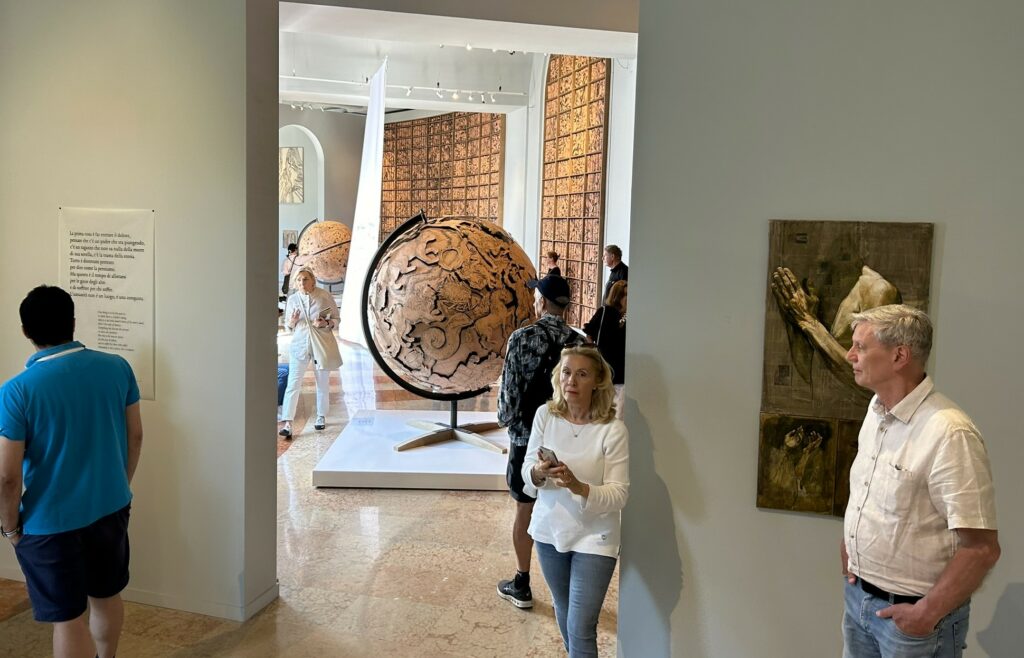
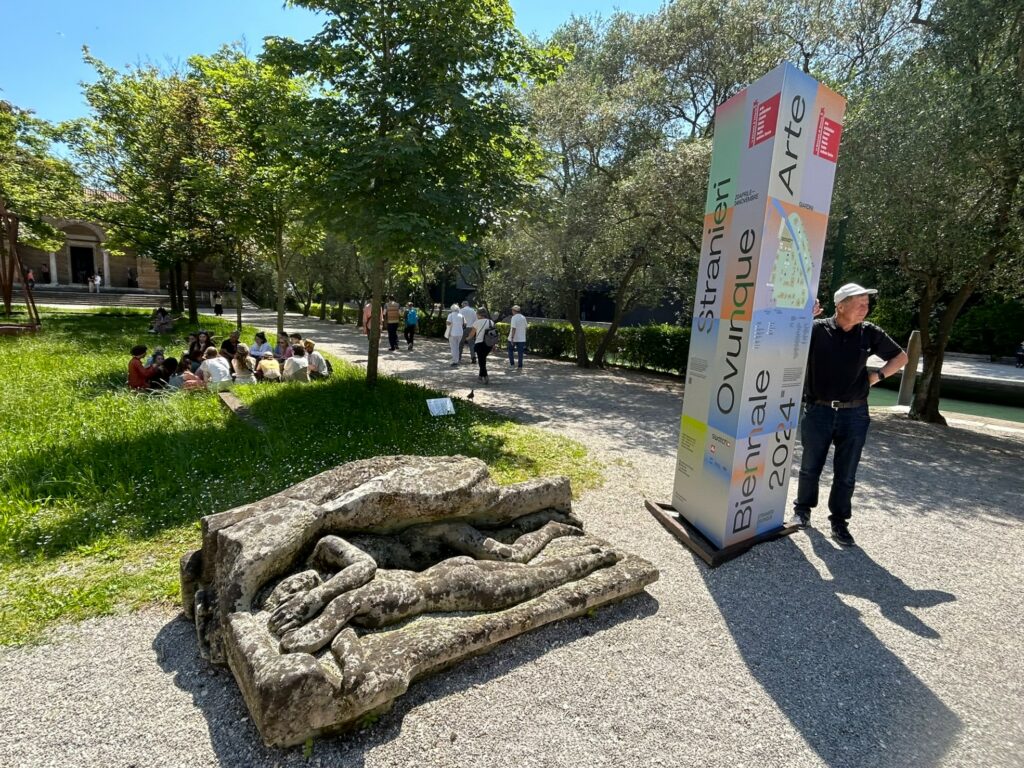
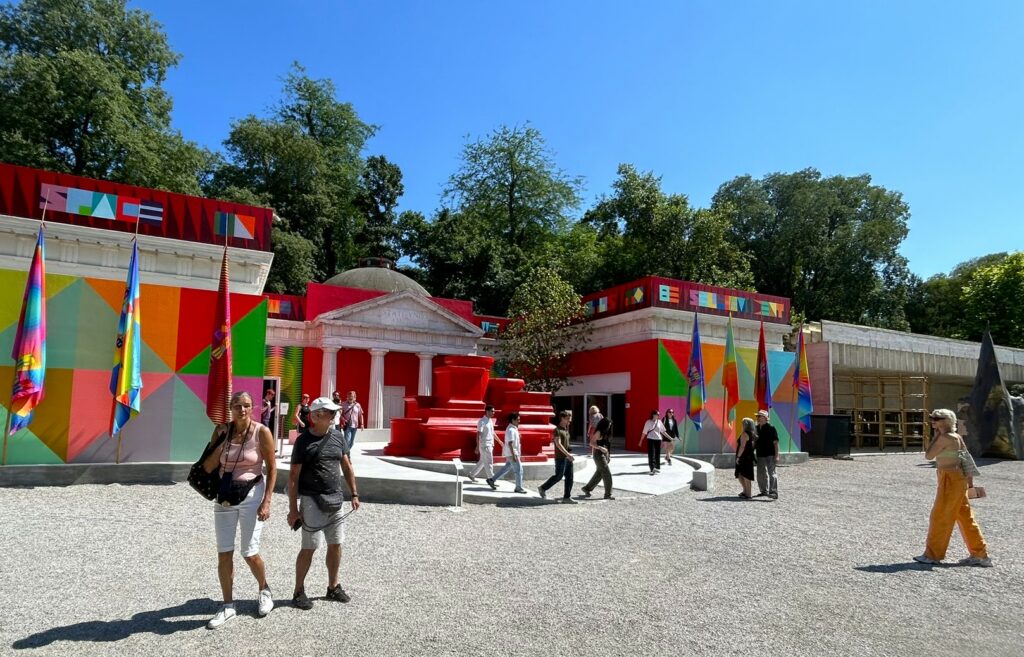
U.S. PAVILION | JEFFREY GIBSON
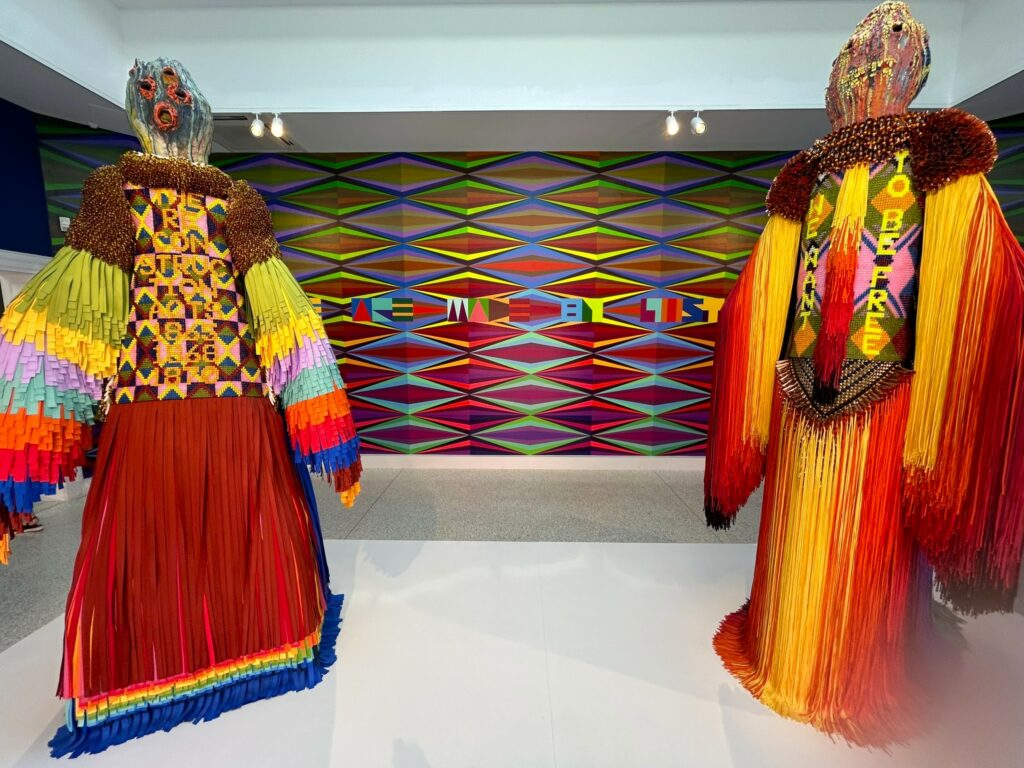
Jeffrey Gibson, the American artist of Cherokee descent, pursues his love of color, craft, and indigenous aesthetics and materials in the United States pavilion, starting on the outside, where he has treated the building to a kaleidoscopic coating of pattern and form. Inside his huge beaded heads and figures—witnesses and guardians of both tragic histories and deep traditions—are woven around with texts from Nina Simone lyrics to Dakota proverbs and Martin Luther King’s admonition that “We are made by history”. On the opening day, fellow artist Mark Bradford and Gibson leapt spontaneously onto the plinth outside the pavilion, which will be used for performances throughout the exhibition. “Today Jeffrey is Diana Ross,” exclaimed Bradford. “I am just a Supreme!”
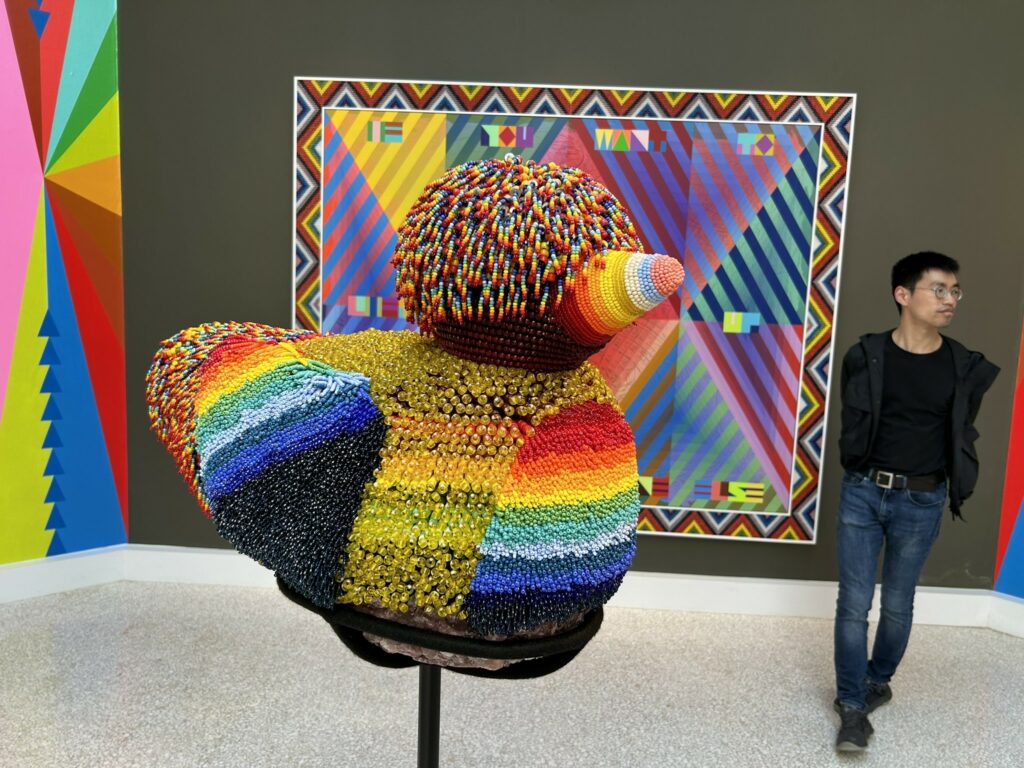
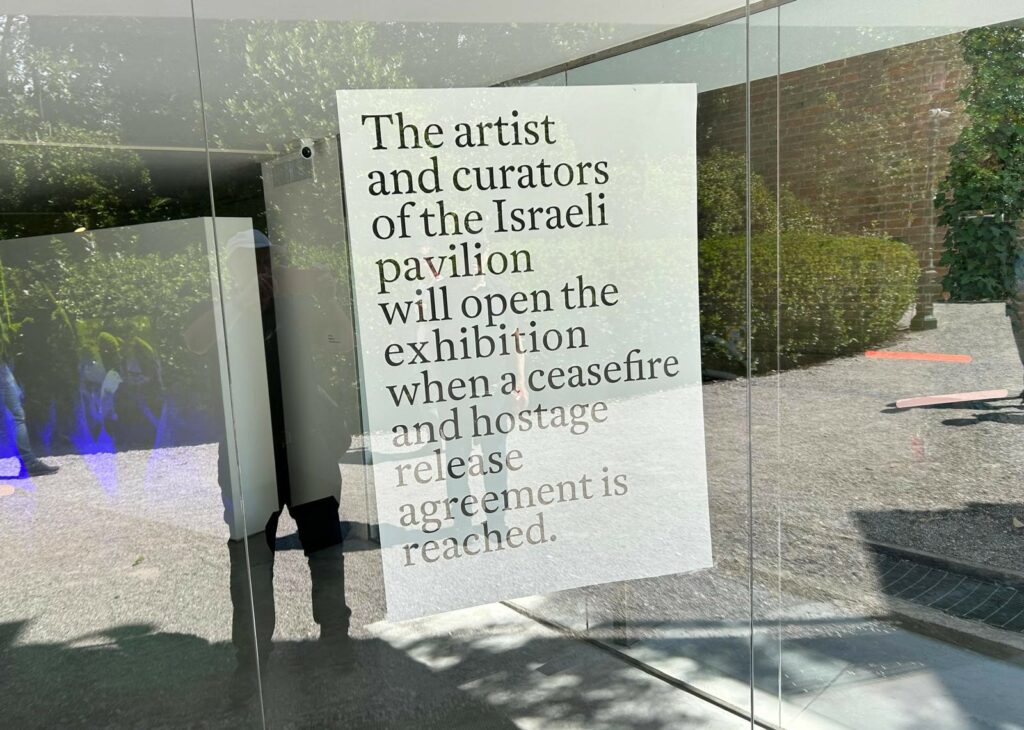
Die Eröffnung begann mit einer Schließung. Am Montag, als in den Giardini die letzten Werke aufgebaut, Kieswege geharkt und Infoschilder angeschraubt wurden, klebten die israelischen Kuratoren ins Fenster ihres modernen weißen Pavillons nur einen Zettel. Die Künstlerin Ruth Patir ließ mitteilen, dass ihre Ausstellung erst gezeigt werde, wenn im Gazakrieg „ein Waffenstillstand und die Freilassung aller Geiseln erreicht ist“. Durchs große Schaufenster sieht man trotzdem eine Videoarbeit von ihr: Eine Zombie-Armee von zum Leben erwachten Tonfiguren schreitet da durch die Straßen einer Großstadt. Zwei Tage später tauchte bei den Vorbesichtigungen eine Gruppe von propalästinensischen Aktivisten auf, und weil im israelischen Pavillon unerwarteterweise gar nichts stattfand, zogen sie zum amerikanischen Pavillon, erstürmten die Skulptur eines indigenen Künstlers, skandierten „From the River to the Sea“ und warfen Flugblätter. Vor dem deutschen Pavillon riefen dieselben Aktivisten „Shame on Germany“, was man im Pavillon aber nicht hören konnte, denn erstens war der Eingang mit einem raumhohen Erdhaufen zugeschüttet worden, und zweitens konkurrieren im Pavillon gleich zwei soundintensive Arbeiten um die Aufmerksamkeit der Besucher.
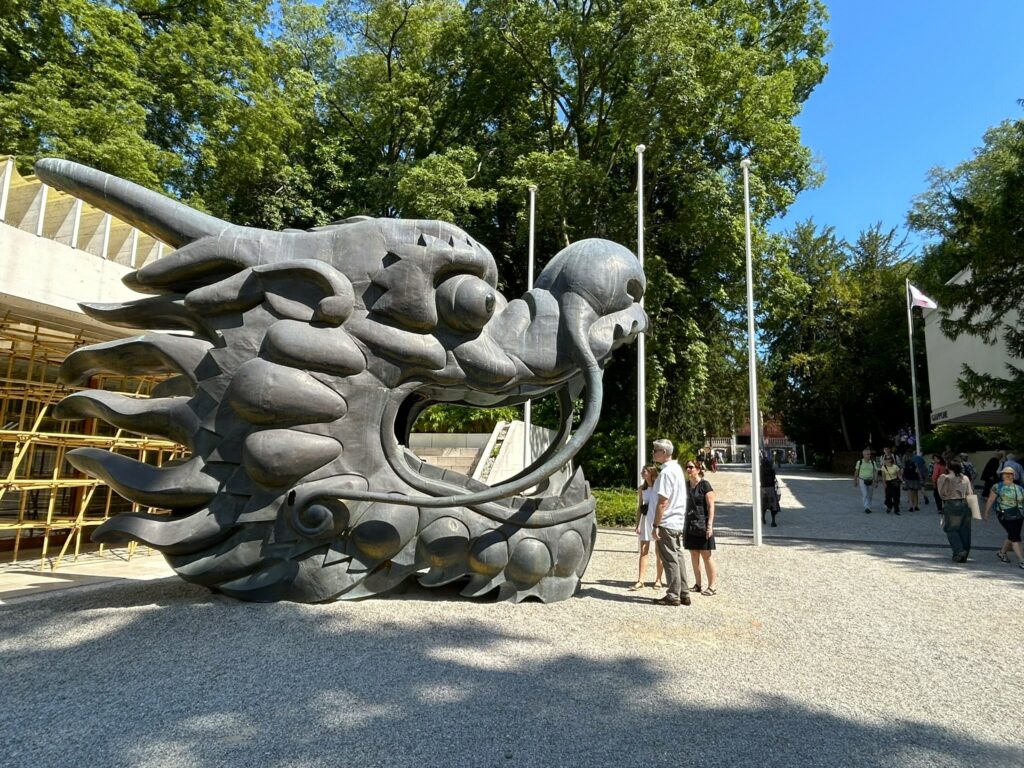
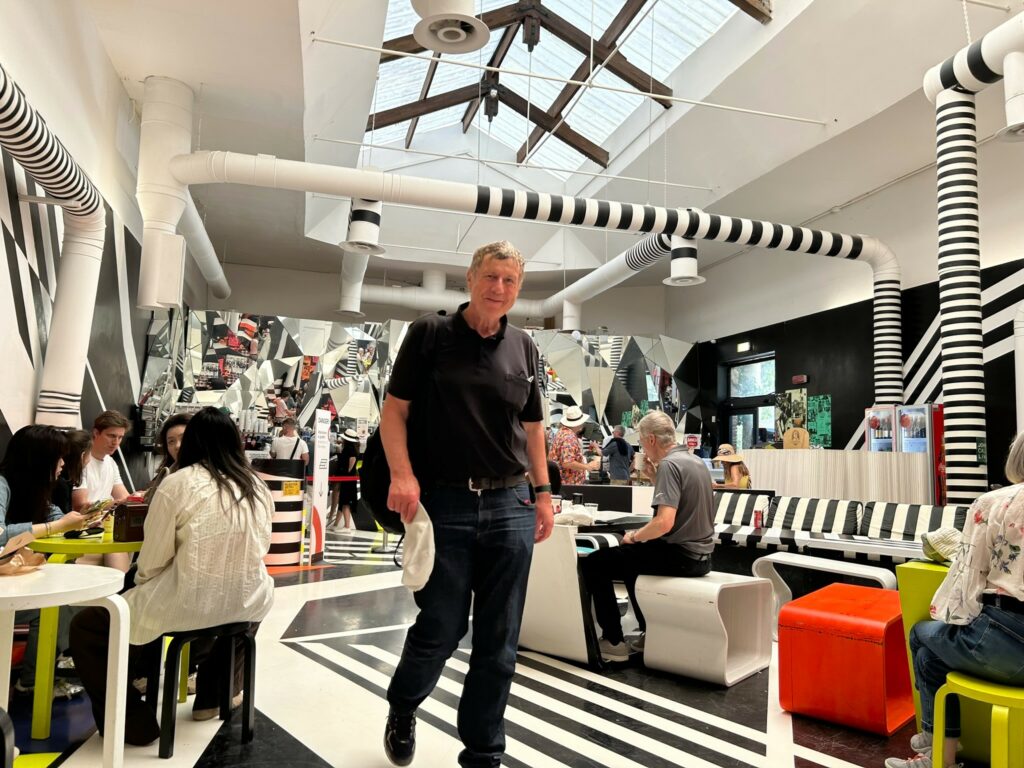
Cafeteria at Palazzo delle esposizioni, Giardini della Biennale
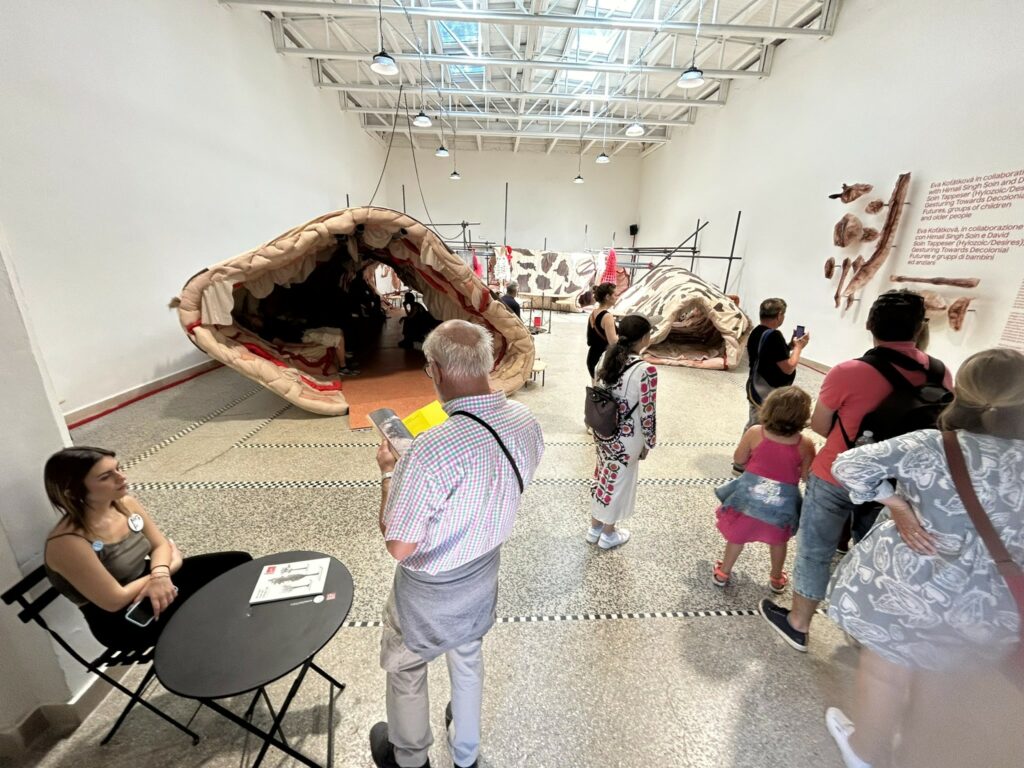
Inside giraffes
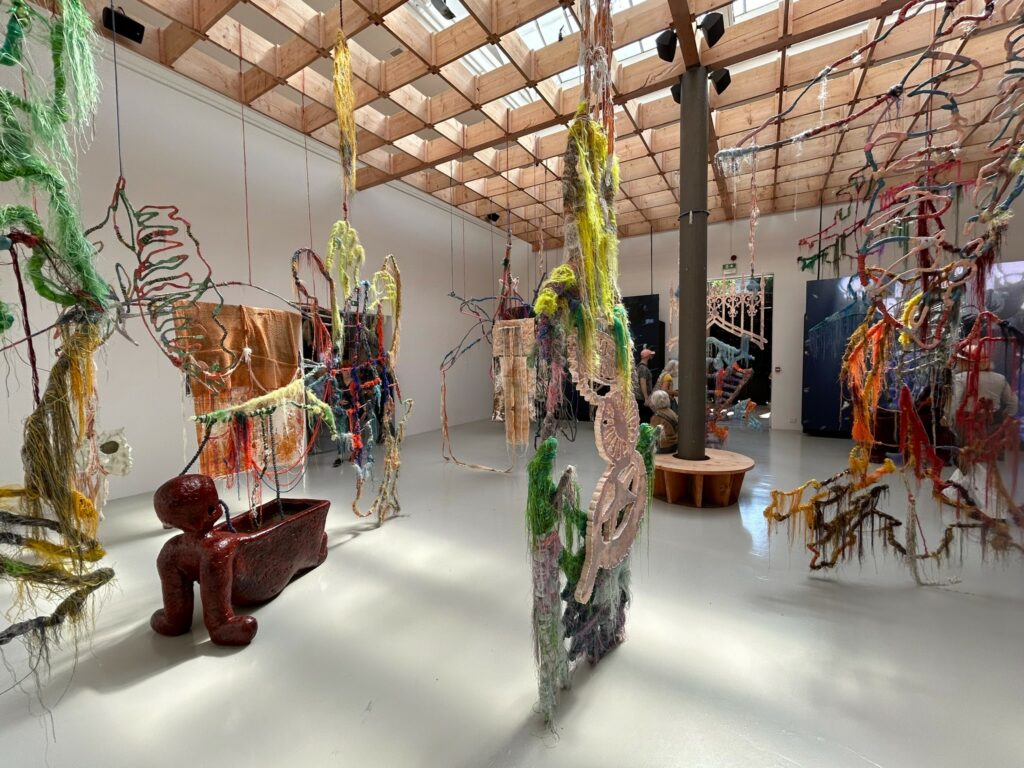
France
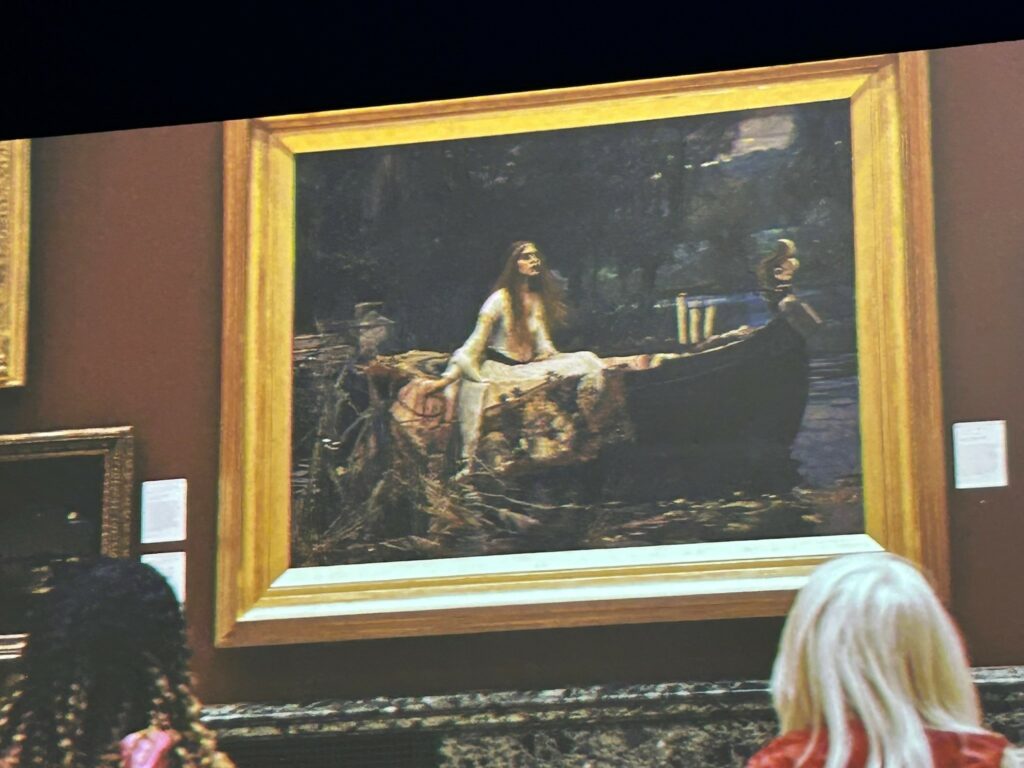
Great Britain
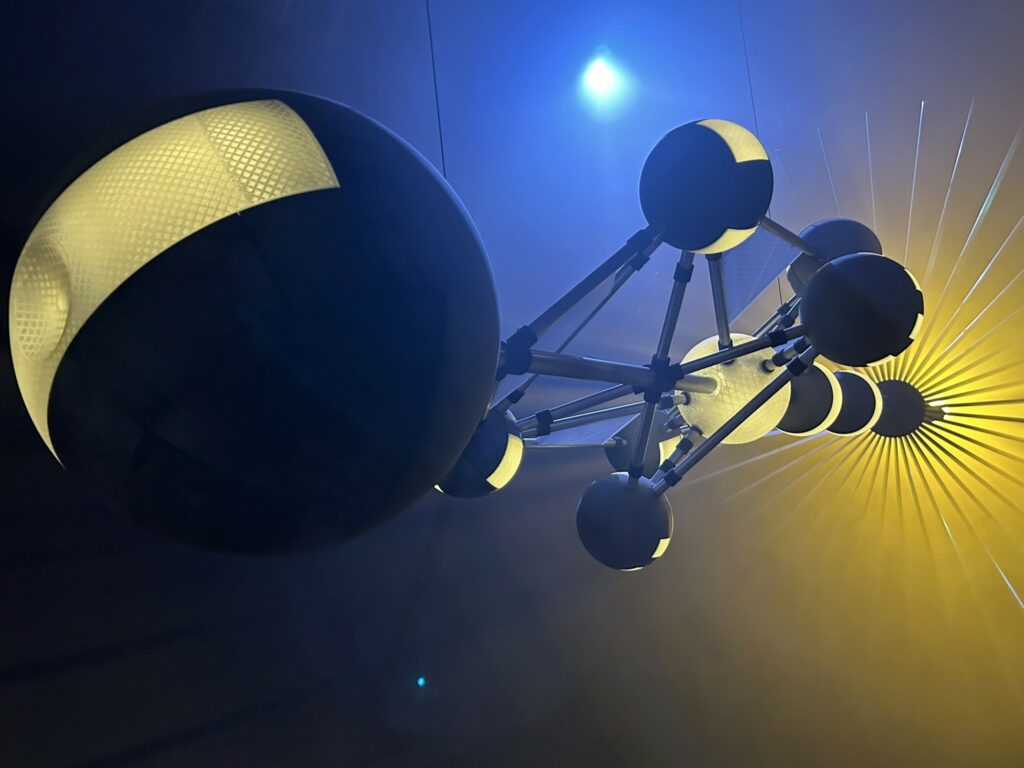
Germany
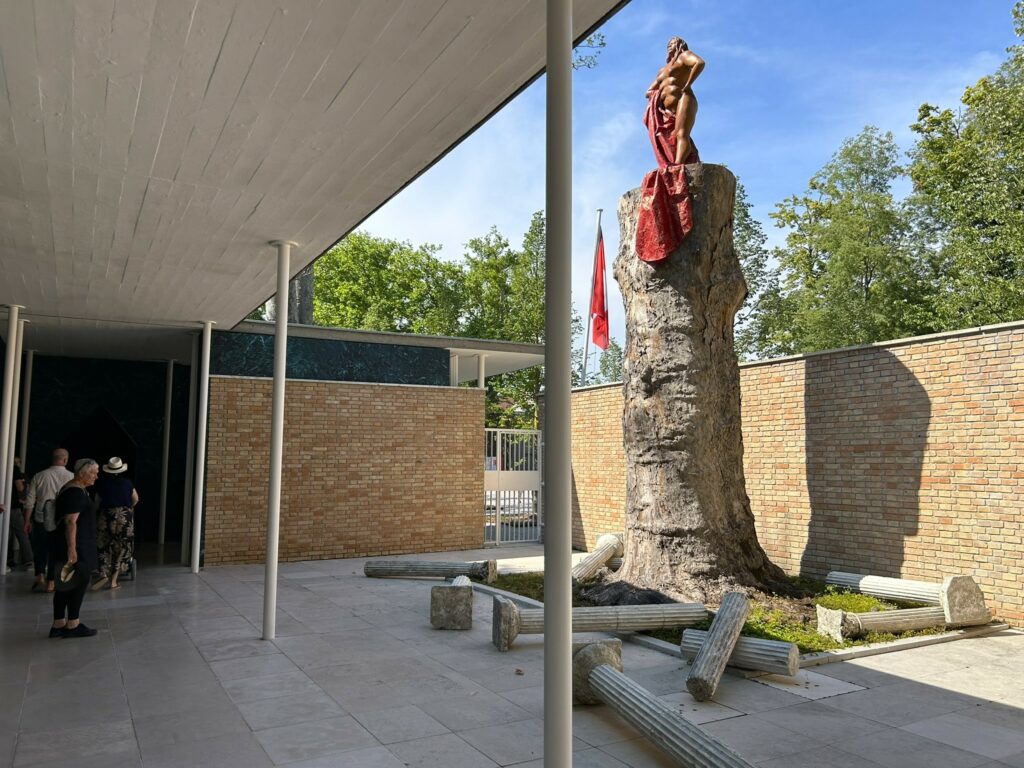
Swiss Pavilion, Giardini
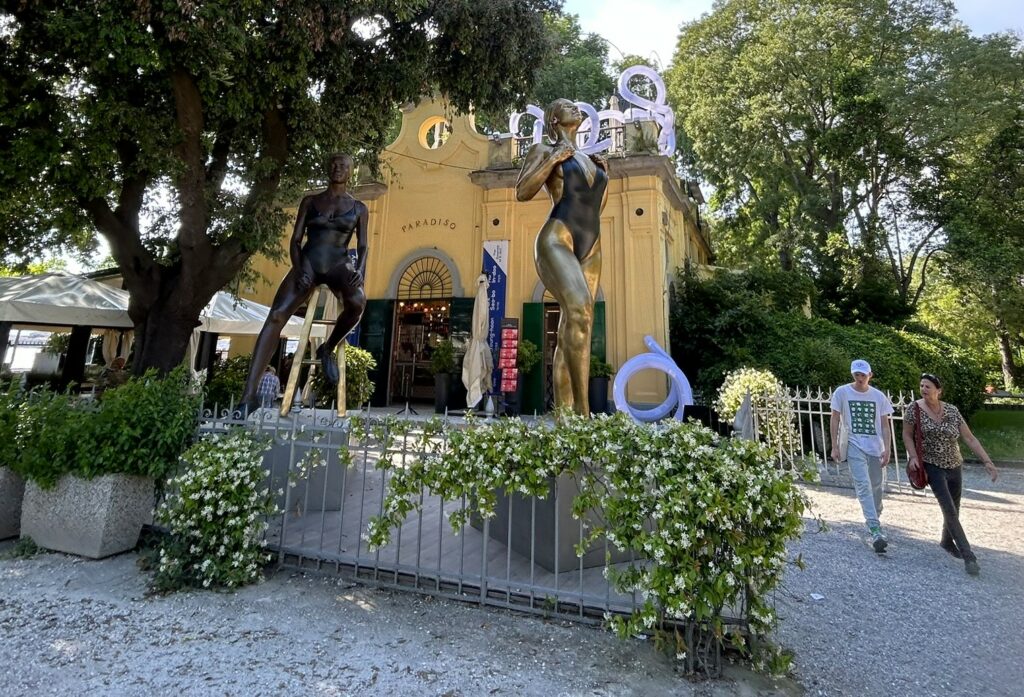
Paradiso Gallery, Giardini
